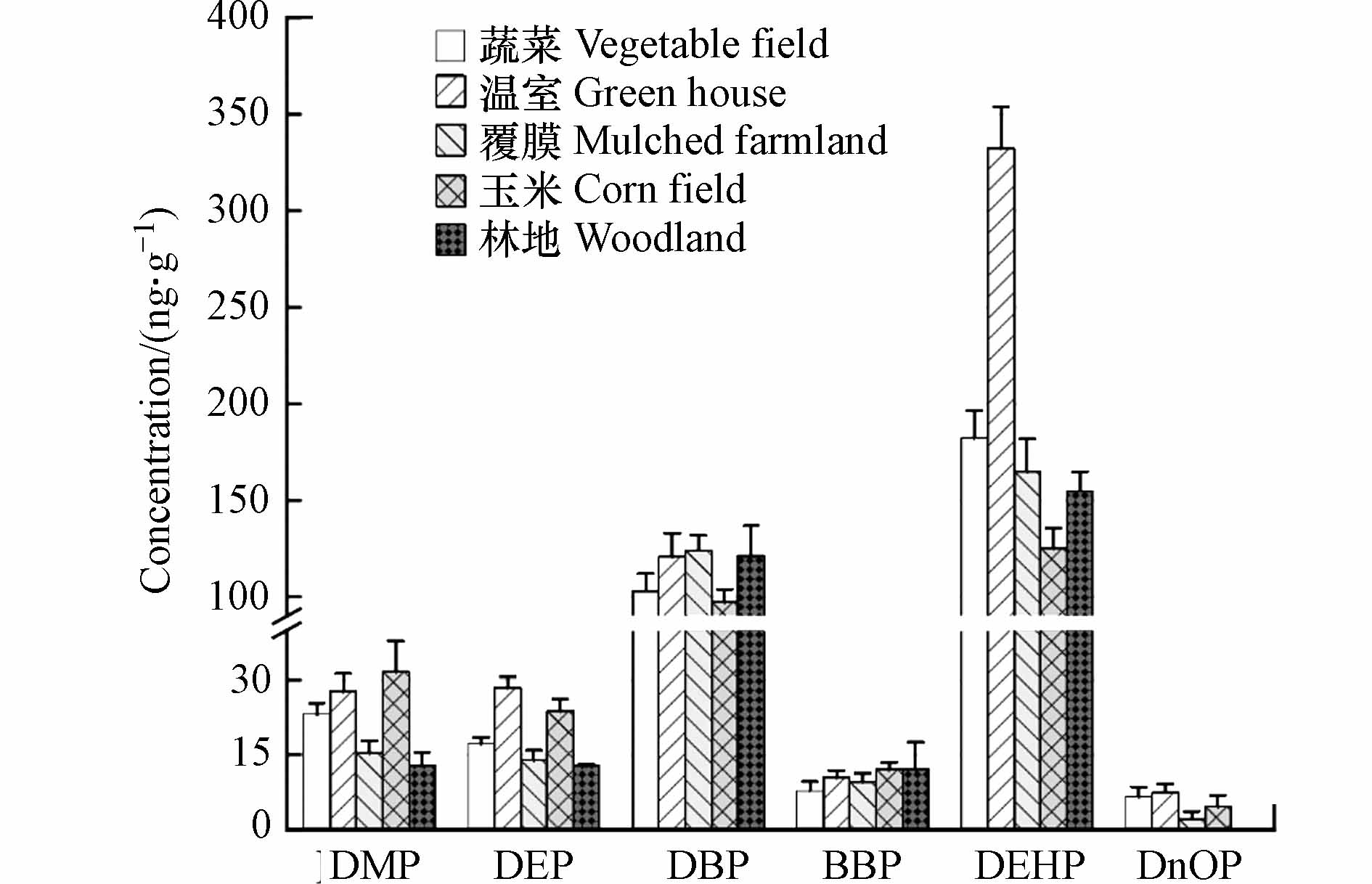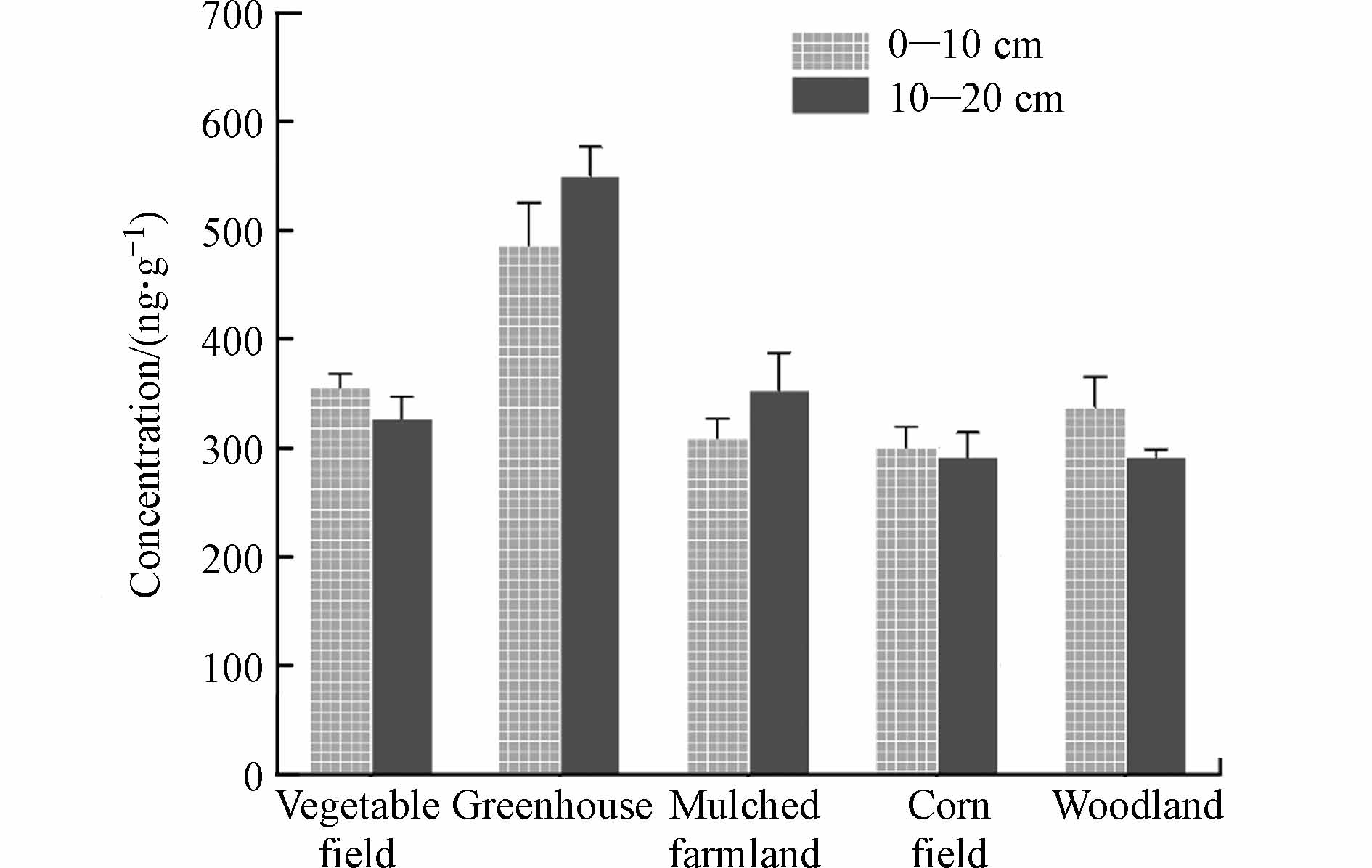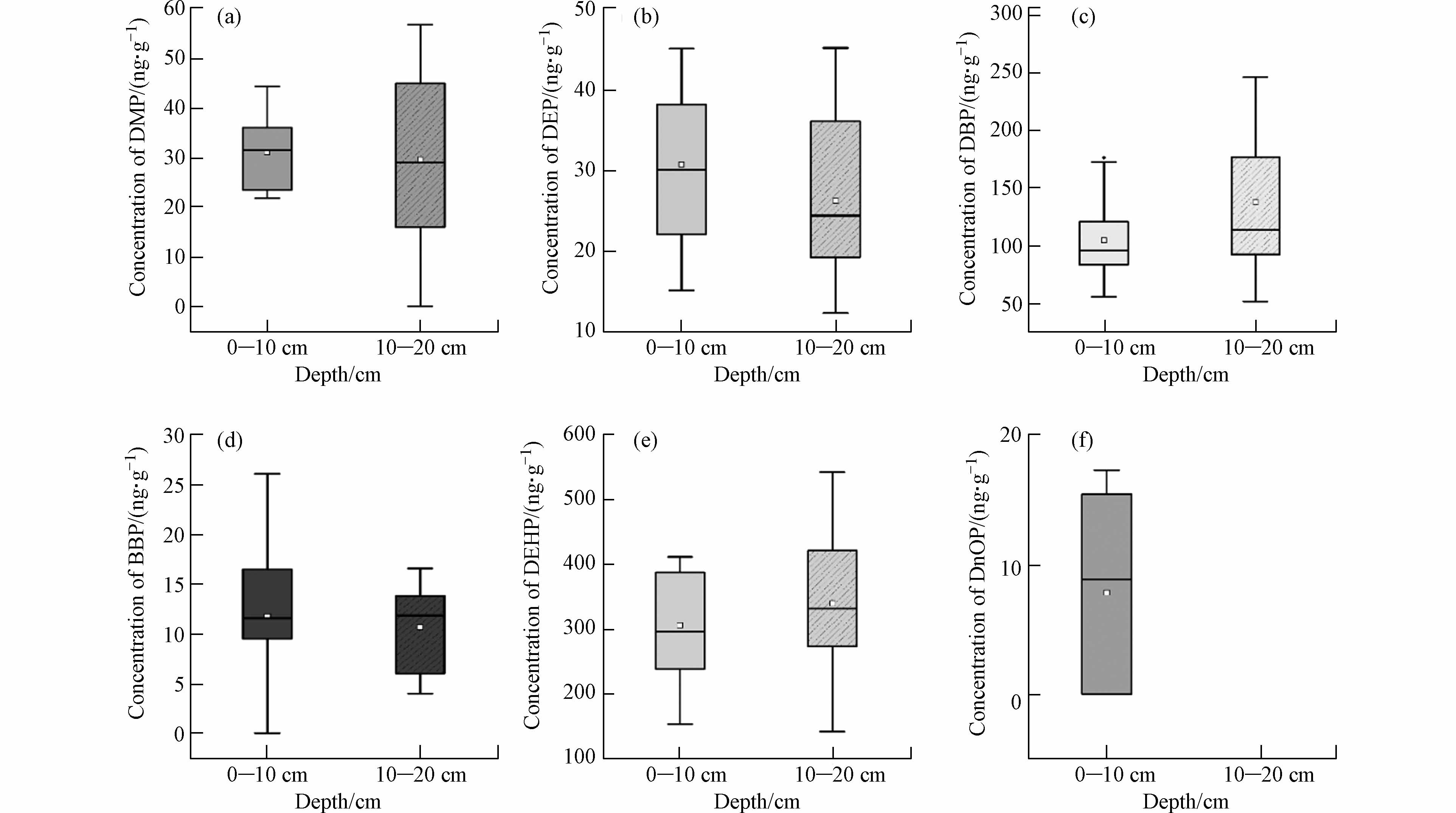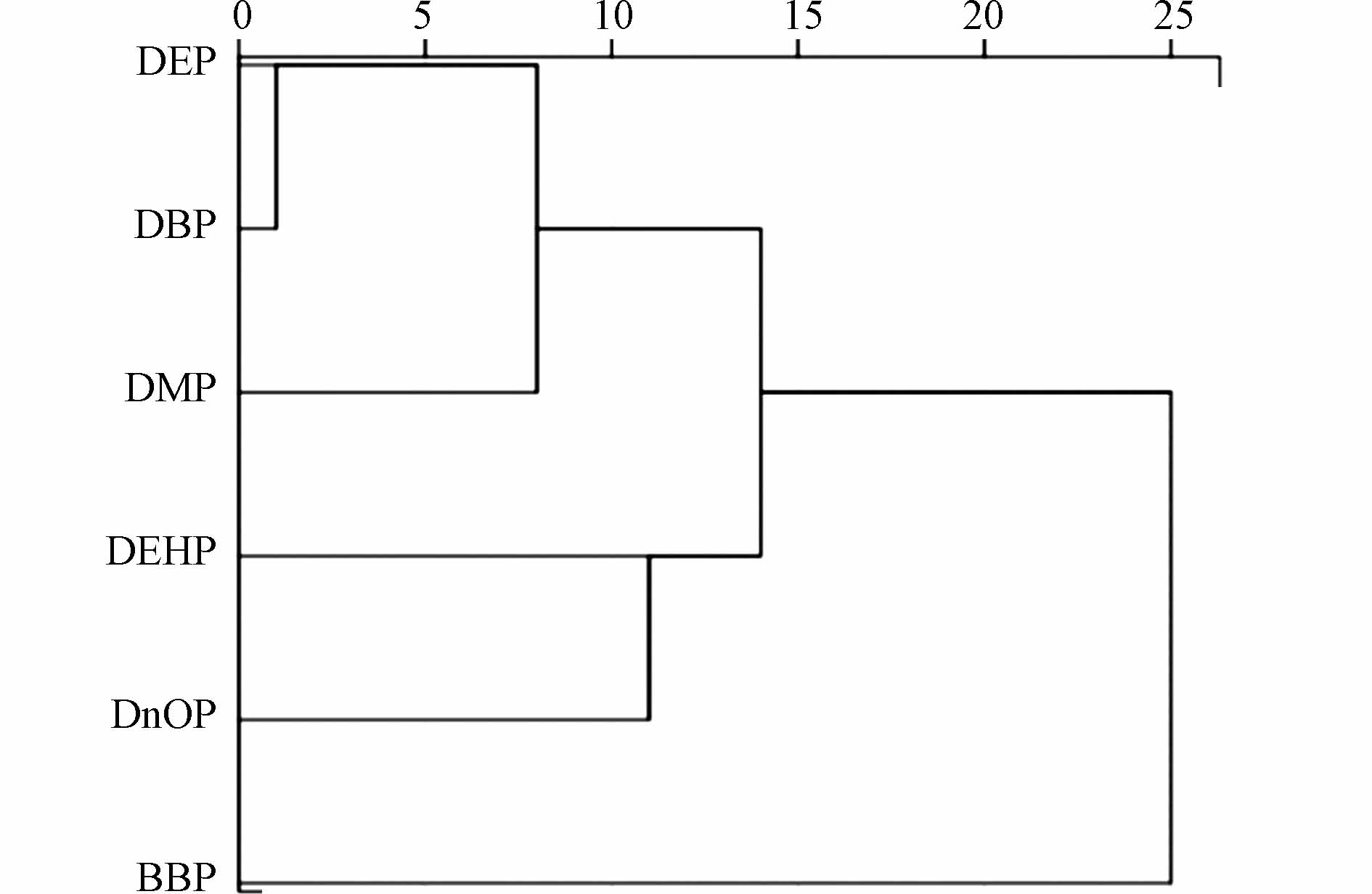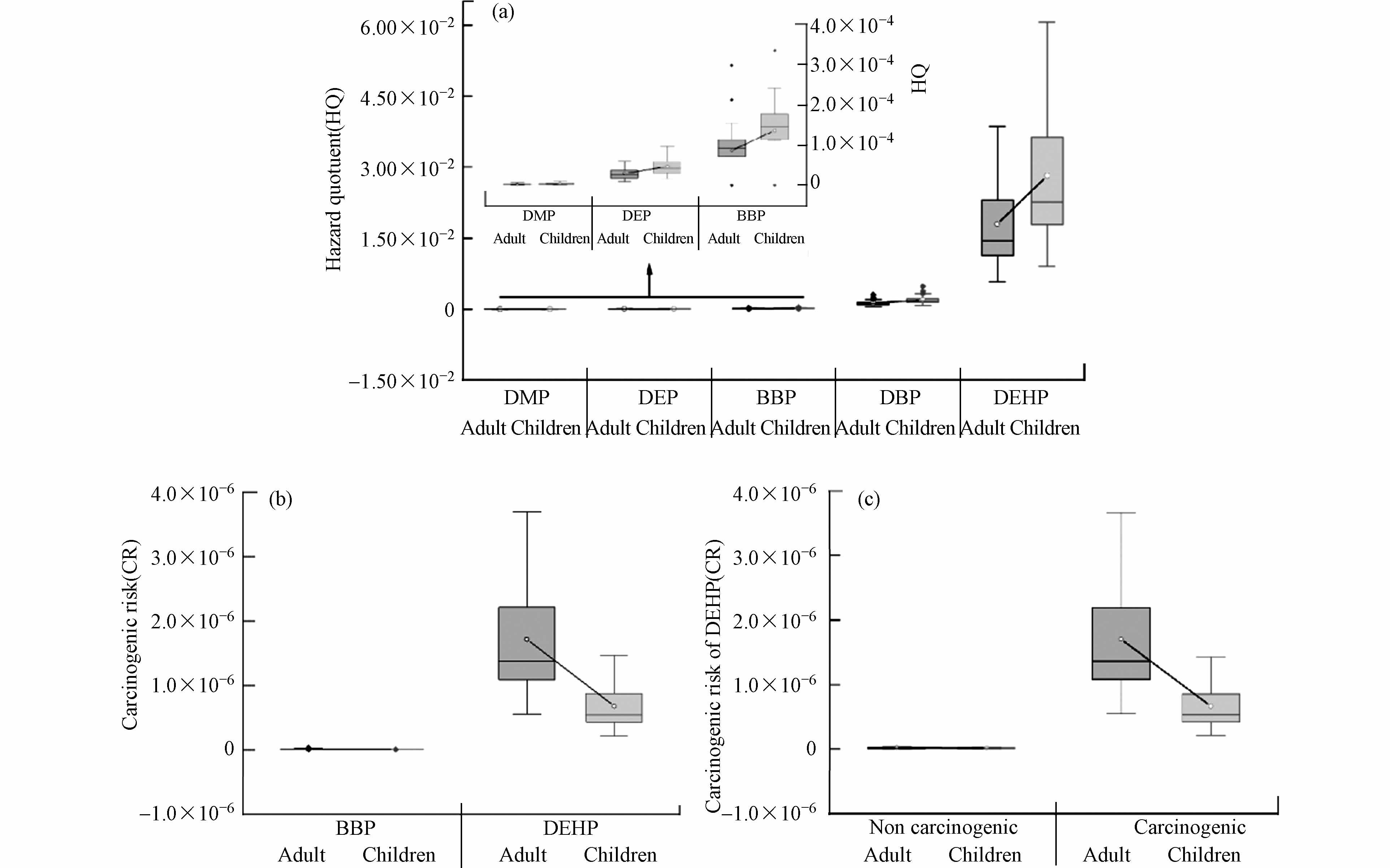-
邻苯二甲酸酯(phthalate esters,PAEs)是邻苯二甲酸形成的酯的统称,近年来因其在塑料、建筑材料、个人护理品、食品包装和医疗产品中的广泛使用而受到越来越多的关注[1]. 由于PAEs与聚合物之间没有化学键合,因此很容易从产品中释放出来. 目前PAEs已经在多种环境基质中检测到,包括空气[2]、水[3]、土壤[4]和生物群体[5]. 作为典型的内分泌干扰物,PAEs具有致畸、致癌和致突变“三致”效应[6],长期接触会带来许多不良后果. 由于PAEs的广泛应用、大规模生产和对人类健康的不利影响,美国环境保护署(USEPA)已将邻苯二甲酸二甲酯(DMP)、邻苯二甲酸二乙酯(DEP)、邻苯二甲酸二丁酯(DBP)、邻苯二甲酸丁苄酯(BBP)、邻苯二甲酸(2-乙基己基)(DEHP)和邻苯二甲酸二辛酯(DnOP)列为6种“优先控制的有毒污染物”,随后我国环境保护局也将DMP、DBP和DnOP列入重点控制污染物黑名单[7].
土壤是重要的环境介质,也是污染物的主要储存库[8]. 近年来,PAEs在土壤中的污染越来越突出,在我国个别地区甚至达到mg·kg−1级别[9],通过食物链对人类健康构成风险,这使它们成为土壤中最受关注的有机污染物之一. 农用薄膜(棚膜和地膜)是我国农业土壤中PAEs污染的重要来源,随着设施农业规模的不断扩大,我国己成为世界上最大的农膜覆盖区[10]. 土壤中的PAEs还与农业实践活动有关,通过各种方式进入土壤环境,例如有机肥料,地表径流,废水灌溉和大气沉降等[11].
目前,国内外很多学者已经开始关注PAEs在土壤中的污染,这些研究涵盖了不同的耕地,包括塑料温室[8, 12]、菜地[13 − 14]、果园[13]、和农田作物[15]等等,然而大多数只分析了一种类型的土地. 农业实践类型受人类活动的影响,并决定了区域环境的植被覆盖和耕作方式,因此PAEs的含量可能与不同的农业类型有关. 事实上,农药、有机肥以及农膜的施用,土壤深度,土壤理化性质及周边污染源的影响均有可能导致不同类型土壤中PAEs的差异[13]. 目前少有关于农业土壤与PAEs污染综合分析的研究.
洋河位于中国北方的胶东半岛,发源于青岛市黄岛区北部,于胶州湾入海. 地处北温带季风区域,降雨主要发生在夏季. 河流两岸主要是村庄、农业区和产业园,农业基础雄厚,粮食生产和经济作物的种植占据主要地位. 同时也有其自身的特点,例如不同的作物种植和不同的覆盖类型. 农田土壤附近多有农药瓶、化肥包装袋、垃圾堆放和农膜残留等现象,“白色污染”不容小觑. 所有这些因素都可能对土壤中PAEs的残留产生影响,目前尚未有关于该地区土壤中PAEs污染的相关报道. 因此,本论文研究了洋河农业区不同实践类型的农业土壤中PAEs的分布模式以及土壤理化性质与PAEs的关系,进一步分析潜在的污染源,为建立农业生态系统中PAEs控制措施提供支持.
-
2021年9月,根据洋河周边的农业生产布局和种植类型(图1),共收集56份具有代表性的土壤样本,包括温室土地(n=22)、覆膜耕地(n=8)、玉米地(n=12)、蔬菜地(n=8)和林地(n=6).遵循五点采样法,每3份子样品形成1个复合样品,钢尺精确测量距离和深度,使用不锈钢铲采集土壤样品(0—10 cm、10—20 cm). 取样时去除枯枝落叶、大块石子以及破碎的塑料薄膜,远离植物根部和刚刚施肥的区域. 样品储存在预先清洗的棕色玻璃瓶中,于−50 ℃冷冻干燥,研磨过100目筛,储存在−4 ℃冰箱中待分析.
-
仪器:气质联用仪(日本岛津,GC-MS 2010Plus);冷冻干燥机(北京亚星,LGJ-10N);超声振荡仪(上海科号,SK5200H);台式离心机(奥豪斯,FC576);涡旋振荡器(上海精业,XW-80A);旋转蒸发仪(BUCHI,R-10);氮吹仪(Organomation Associates,N-EVAP111).
试剂:6种PAEs混合标准溶液(DMP、DEP、DBP、BBP、DEHP和DnOP)和内标物(磷酸三丁酯-d27、苯甲酸苄酯)浓度均为1000 µg·mL−1,购自美国AccuStandard公司;正己烷、丙酮和二氯甲烷均为色谱级,购自天津科密欧公司. 柱层析硅胶(100—200 目,青岛海洋化工厂)和氧化铝(100—200目,上海国药试剂)使用前分别在180 ℃和400 ℃活化4 h,冷却后加入5%去离子水;无水硫酸钠(分析纯,上海国药试剂)使用前在马弗炉450 ℃灼烧4 h.
-
参考之前的文献方法[16],准确称取10.0 g样品置于玻璃离心管中,添加已知量的磷酸三丁酯-d27,加入20 mL正己烷-丙酮(1:1, V/V)涡旋混合,经两次超声(35 ℃,15 min)和离心(3000 r·min−1,10 min),合并上清液. 上清液经旋蒸浓缩后,转移至从下到上填充有中性氧化铝-硅胶-无水硫酸钠(高度分别为6 cm、12 cm和1 cm)的玻璃层析柱中,依次用20 mL正己烷、20 mL二氯甲烷-丙酮混合液(1:1, V/V)和20 mL乙酸乙酯洗脱. 氮气条件下吹干,加入已知量的苯甲酸苄酯,正己烷定容到200 µL.
同时分析了土壤样品的理化性质:土壤pH通过多参数水质检测仪(美国HACH)在土壤-水(1:2.5, W/V)提取中测量;元素分析仪(德国Elementar)用来测定土壤中的总有机碳(TOC)和总氮(TN).
-
色谱条件:使用GC-MS 2010Plus(日本岛津)和DB-5MS石英毛细管柱(30 m×0.25 mm×0.25 µm)进行色谱分离. 载气:高纯氮气;柱流量:1 mL·min−1;进样体积:1 µL,不分流进样;进样口和柱箱温度分别为250 ℃和50 ℃. 升温程序:初温50 °C,保持1 min,以15 °C·min−1的速率升温至200 °C,保持2 min;以8 ℃·min−1的速率升温至300 °C,保持8 min.
质谱条件:选择性离子监测为SCAN模式,离子源和传输线温度分别为230 ℃和280 ℃.
-
实验过程中不使用任何塑料制品,所有非计量玻璃器皿经纯水洗涤和有机溶剂淋洗后经马弗炉450 ℃灼烧4 h. 分析过程中,每12个样品进行一组程序空白、基质加标和样品平行样. 在程序空白中检测到少量DBP、DEHP,实际检测样品均经过空白校正. 将回收内标添加到所有样品中,回收率为81.21%±5.38%. 6种目标单体的回收率范围为78.32%—118.63%,相对标准偏差<10%. 仪器检出限定义为信噪比的3倍,范围为0.61—2.36 ng·L−1. 采用0.05、0.1、0.2、0.5、1、5、10、20 ng·L−1的6种PAEs绘制标曲,各物质标曲R2=0.995—0.999,满足要求.
-
洋河农业区内居民的非致癌和致癌风险根据USPEA推荐的模型进行评估. DMP、DEP、DBP、和DnOP被认为是与人体健康相关的非致癌物质,DEHP和BBP是致癌物质. 当地居民主要通过饮食途径(食物摄入)和非饮食途径(土壤摄入、皮肤接触、呼吸)摄入PAEs. 公式如下:
其中,Csoil是土壤中目标单体的浓度(mg·kg−1);ADDi是饮食或非饮食途径的日平均摄入量(mg·kg−1·d−1);HQ为非致癌风险;CR为致癌风险,其它参数见详见表1. 对于非致癌物质,若HQ>1,则该物质表现出非致癌风险;对于致癌物质,若CR>10−6,则该物质表现出致癌风险,通常认为CR>10−4是不可接受的.
-
洋河流域农业土壤中PAEs各单体含量以及检出情况见表2. 6种PAEs单体在土壤中的平均含量顺序依次为DEHP>DBP>DMP>DEP>BBP>DnOP. 除DnOP外,其余单体检出率在80%以上,意味着这些物质在该地区被广泛使用. Σ6PAEs含量范围在183.63—780.50 ng·g−1,平均值和中位数分别为396.75 ng·g−1和365.87 ng·g−1. DEHP是土壤中最丰富的单体,含量范围在70.77—473.15 ng·g−1,平均值为219.98 ng·g−1,占Σ6PAEs的平均百分比为55.45%. 其次是DBP,占比为28.74%. DMP和DEP含量相当,占比分别为6.21%和5.60%. BBP和DnOP的占比相对较低,二者总占比仅为4.00%. 其中,DMP和DBP均超过了美国纽约州制定的土壤PAEs控制标准,超标率为32%和48%,最高超标分别达到3.1倍和3.5倍,值得关注和重视.
洋河农业区土壤中PAEs组成以DEHP和DBP为主,与西安城市[19]、雷州半岛[20]报道的情况类似. PAEs各单体含量差异,可能与单体性质、环境来源以及土壤的理化性质和环境条件有关[14]. DEHP和DBP由于分子量相对较大,水溶性较低,辛醇-水分配系数(lgKow)较大,在土壤中易于吸附富集,流动性较差,导致质量百分比偏高;而DMP、DEP等短链PAEs的水溶性相对较高,lgKow相对较小,相比于较长的烷基碳链的PAEs,更易被生物降解或通过挥发、淋溶和植物吸收等途径消失[21]. 另外,DEHP、DBP是农膜中使用最广泛的增塑剂,在各种有机肥料中也被大量检测到,因此在农业土壤中的应用范围更广.
如表3所示,洋河农业区PAEs污染程度与北京温室和泰安温室土壤基本相似,高于东北三江平原和黄河三角洲,但低于银川和天津菜地土壤. 不难看出土壤中PAEs污染水平有一定的区域差异性,分析这种差异可能归因于地区间不同的灌溉方式、土地利用方式和种植结构等[13]. 洋河流域是青岛市典型的灌溉农业区,利用洋河水源沿流域两岸农田自流灌溉. 关于灌溉水中的PAEs污染已有报道,特别是在地表河流和湖泊中[22]. 尽管地表水环境的PAEs含量低得多,但随着时间的推移,河水从灌溉源到农田的运输过程可能会导致PAEs在土壤中的积累. 与印度和英格兰相比,洋河农业区土壤中PAEs各单体污染水平明显偏高,这与我国的人口基数与塑料制品的需求量大密切相关.
-
洋河农业区不同类型土壤中Σ6PAEs的含量情况见表4. Σ6PAEs的平均含量由高到低依次为:温室土壤(518.38 ng·g−1)>蔬菜地(341.13 ng·g−1)>覆膜耕地(331.02 ng·g−1)>林地(314.56 ng·g−1)>玉米地(295.74 ng·g−1). 整体上,不同类型土壤的Σ6PAEs含量差异不显著,不存在严重的局部偏差. 可能是该地区以农业生产为主,远离城市和工厂,工业活动和城市垃圾产生的PAEs有限.
温室土壤中PAEs来源较为复杂. 一方面与棚膜的使用有关,另一方面,温室频繁地进行人为干预,如大水漫灌、化肥与农药杀虫剂大量施用等[29],这种集约化管理方式导致温室土壤中PAEs浓度显著高于其它农业土壤;地膜只在作物生长季节铺设,覆盖时间短,释放出的PAEs较少,且通过淋溶、下渗等途径迁移[18],因此覆膜耕地中残留的PAEs低于温室土壤;相比之下,蔬菜地由于不受地膜的阻挡或庇护,来自有机肥料、生活垃圾和道路交通灰尘的外部输入都可能是土壤中PAEs的重要来源;大气沉降或许是造成林地中PAE累积的原因:PAEs在土壤大气环境中的交换主要通过两个途径:一是大气中黏附有PAEs的气溶胶颗粒通过干沉降和湿沉降的方式进入土壤,二是土壤赋存态PAEs向大气环境中挥发[30],其中沉降为主要途径. 相对于普通露天农田而言,林地具有一定的阻挡作用,大气中的PAEs更容易在此处沉降[18];本研究中玉米种植土壤中PAEs含量最低,可能是因为采样时间为9月,临近玉米收获期,土壤耕作以及化肥和农药的施用频率降低.
评估土壤中PAEs污染情况,仅考虑其总浓度是不够的,还应考虑污染物单体的组成和浓度范围(图2). 尽管不同农业土壤中PAEs单体平均含量不尽相同,但贡献率较高的单体(DEHP、DBP)与研究区主要污染组成情况相一致. 其中,DEHP占Σ6PAEs百分比范围分别是42.42%—62.26%,顺序依次为温室土壤(62.26%)、蔬菜土壤(53.52%)、覆膜耕地(49.90%)、林地土壤(49.31%)、玉米土壤(42.42%);而DBP在不同土壤类型中的占比相差不大,占比范围在23.36%—38.63%.
就单体检出含量来看(图3),DBP和DEHP在温室土壤中的平均浓度均高于蔬菜地、玉米地和林地,其余几种单体未见显著增高. 相反,玉米土壤中DMP和DEP的平均浓度较温室土壤还略高.
对于覆膜土壤而言,DBP的平均含量和占比高于3种露天土壤,这与DBP常作为增塑剂这一事实一致,但只对玉米土壤来说差异显著(P=0.019,<0.05). 这可以解释为,采样时间为9月,覆膜土壤经过了整个夏季的太阳辐射和雨季降水. 尽管DBP较高的溶解度和蒸汽压使其容易从塑料薄膜中渗出,但覆膜环境下适宜的温度和湿度条件可能会促进DBP的降解,从而打破土壤中PAEs输入和减少之间的平衡. Wu等[31]的研究支持了这一结果:随着温度从25 °C升高到30°C,土壤中DBP的降解速率迅速增加. Wang等[32]将聚乙烯农膜埋在土壤中4年,农膜中的PAEs浓度降低了79.2%—98.0%,然而农膜覆盖下的土壤与附近土壤背景之间几乎没有发现PAEs浓度的差异. Xie等[33]报道,DBP在28 °C时的半衰期为8.53 d,意味着农膜中释放的DBP在土壤中的保留时间较短. 事实上,覆膜土壤中其余单体含量(DEHP除外)均处于较低水平,说明PAEs确实容易在该环境下降解. 同样作为塑料制品中使用最广泛的增塑剂,覆膜土壤中的DEHP呈现出与DBP类似的规律,但平均浓度要高于DBP. DEHP的半衰期在18.5—41.4 d[32],是DBP的8—10倍,相比之下较难被微生物降解. 另外,DEHP是有机肥料中最常被检测到的物质,地膜的覆盖一定程度上阻碍其输入,因此DEHP浓度小于蔬菜土壤也就不足为奇了. 由此可见,地膜覆盖对土壤中PAEs的残留影响较小.
-
一些研究表明,随着土壤深度的增加,土壤中PAEs浓度逐渐降低[34]. 然而该规律仅在蔬菜地、玉米地和林地中得以体现(图4),原因可能是林地土壤质地紧实、偏砂质,PAEs更倾向于在地表积累而难以渗透到深层当中. 已经证实,植物根部的PAEs的含量显著高于土壤中,意味着植物可以通过根部从土壤中吸收和积累PAEs[35]. 因此对于玉米和蔬菜地而言,体现在10—20 cm土壤中PAEs的含量的低于0—10 cm. 这种趋势与温室和覆膜耕地明显不同,土壤的频繁翻转可以部分解释这种差异,特别是对于温室来说,频繁翻转可能会增加土壤中PAEs的挥发并促进好氧生物降解,从而降低PAEs在表层土壤中的浓度.
本研究土壤中(蔬菜地、玉米地和林地)呈现的变化趋势与江汉农田土壤不一致[36],这种差异可能归因于降雨对PAEs浸出的影响. 江汉平原处于水循环非常活跃的气候潮湿地区,通过土壤浸出的水会将PAEs沿土壤剖面输送到深处. 由于此处相对缺乏氧气和微生物质,PAEs的降解速率受限,因此土壤深层的PAEs含量较高. 在洋河流域,农业耕地通常每半年一犁,温室则更为频繁,这有助于PAEs在浅层和深层之间的垂直转移,可能是导致不同层间PAEs含量差异不够显著的原因. 总体而言,不同研究中PAEs垂直分布可能与许多因素有关,包括土壤耕作、采样深度、降水以及生物和机械干扰[10].
另一个值得关注的问题是PAEs单体随深度的变化情况. 以温室为例,DnOP在深层土壤中均没有被检出,其余5种单体均存在下渗的情况,但分布规律不尽相同(图5). DMP在各层间含量相当,由于水溶性和易于降解,因此在土壤各层中污染程度不高;DBP有与相似的物理性质和化学结构,其分布规律与DMP类似. DBP溶解度大、易于下渗,温室土壤灌溉频率较高,因此更容易向土壤深处迁移. DEHP作为最主要污染物,分布情况与Σ6PAEs相同,主要集中在深层,但各层的残留也较高. BBP土壤中污染程度小,在深层土壤中很少检出.
-
为了进一步了解洋河农业区PAEs的各种潜在来源以及典型理化性质对土壤中PAEs积累之间的关系,本研究计算了PAEs单体残留水平与土壤理化性质之间的Spearman相关系数,如图6所示. 结果表明,土壤中发现的主要单体(DEP、DBP和DEHP)的浓度彼此之间有明显的相关性(P<0.05),并且这3种单体与Σ6PAEs密切相关(r=0.67、0.62和0.93;P<0.01). 这些相关性可能表明各种单体在土壤中可能有类似的输入途径和命运.
TOC、TN和pH是影响包括PAEs在内的疏水性有机污染物(HOCs)行为的重要因素. 本研究区域土壤中TOC、TP和pH值范围为0.130%—1.348%、0.001‰—0.086%和4.92—7.74,平均值为0.423%、0.031%和6.47. 其中,TOC值远低于北京(0.97%)[37]、寿光(1.14%)[38]等地区. 与其它HOCs一样,PAEs亲油性强、易与有机物结合,这一物理化学特性使得PAEs很大程度上会被土壤有机质吸附[39],因此研究区土壤中较低的TOC含量可能是导致土壤捕获PAEs较低的原因. 然而PAEs和TOC之间没有相关性,可能是环境中存在连续的HOCs来源,导致HOCs与TOC之间不相关[40]. 在洋河农业区,农药、化肥与农用塑料被频繁使用或更换,这些含有丰富PAEs的新鲜材料被连续引入土壤中,可能会打破PAEs和TOC之间的平衡. 在山东半岛的温室土壤中也发现了类似的现象[41]. 另外,本研究中也没有发现PAEs与土壤pH和TN值之间的相关性.
-
污染物的环境来源诊断对于风险管理和环境修复具有重要意义. 本研究中,主成分分析和聚类分析被用于识别PAEs的环境来源. 考虑到本研究区域可用于林地、覆膜和蔬菜的样本量相对有限,因此将所有土壤样本组合在一起进行分析. 土壤中PAEs主成分分析(KMO值为0.756,Bartlett's球形检验显著)结果见表5,使用kaiser进行标准化正交旋转,提取了4个主成分。
第一主成分(PC1)方差贡献率为43.75%,DEHP和DnOP载荷较高,单体之间呈显著正相关(r=0.43,P<0.05),说明它们可能有相似的来源. 研究表明,DEHP和DnOP主要用作增塑剂[1]. 其中,DEHP是应用最为广泛的PAEs类增塑剂,能添加到于大多数塑料中,如PVC. DnOP也应用于乙烯地板的生成,油墨、皮革等橡胶制品中[42].
第二主成分(PC2)方差贡献率为15.82%,DMP的载荷最高. 主要作为农药和杀虫剂中的溶剂,化妆品和个人护理品中也有所检出[43].
第三主成分(PC3)方差贡献率为12.96%,由DBP与部分DEP构成,呈现显著相关性(r=0.54,P<0.05). 有报道称化肥中含有DBP和DEP[43]. 其次DBP也是常用的PAEs类增塑剂之一.
第四主成分(PC4)方差贡献率为11.19%,BBP载荷最高. BBP多来源于增塑剂,建筑和装饰材料的挥发,以及含有PAEs颗粒的大气沉积[42].
聚类分析(图7)将土壤中的PAEs分为4类:DEP和DBP为类1,DEHP和DnOP为类2,DMP、BBP分别为类3和类4,与主成分分析结果一致. 同时,类1、类2和类3在高更层次又形成了的一个新的集群,这反映出它们可能还有另一个共同的环境来源.
通常认为,PAEs的支链长度与来源相关[44]. 农业生态系统中,短链PAEs,如DMP和DEP,通常来源于农药、污灌和有机肥;而长链PAEs,如DBP、DEHP、BBP和DnOP,在聚合物工业中被广泛用作增塑剂,约80%的PAEs用于此目的,在聚体中的含量从10%—60%不等[1]. 本研究区的PAEs主要以DBP和DEHP为主,这与我国主要使用它们为增塑剂的事实一致,但主成分分析和聚类分析结果表明这两种单体并不属于一类,说明它们可能具有复合来源. 实地考察发现,洋河农业区土壤中PAEs的来源具有一定的复杂性和广泛性. 一方面,这两种单体广泛存在于各个环境介质(水、土壤和大气)和农业投入品(塑料增塑剂、有机肥和污灌)中[45]. 另一方面,覆膜下适宜的湿度和温度促使农膜中释放的PAEs迅速减少,特别是对DBP来说. 相比之下BBP和DnOP来源较为单一,主要作为增塑剂随塑料制品进入土壤,这也就解释了为什么BBP和DnOP在洋河农业区不同类型土壤中显示出较强的特异性,体现在3种露天农田土壤中的检出率和含量都很低.
-
根据1.6中的健康风险模型,计算出不同暴露途径下成人和儿童对PAEs的日均摄入量(表6). 由于DnOP检出率较低,因此不进行计算. 从各单体对日均摄入量的贡献来看,无论是对于成人还是儿童,DEHP所占比例最大,约为65.0%. 从各种暴露途径来看,饮食途径的日均摄入量均显著高于非饮食途径,其对日均摄入量的贡献率分别为成人的98.5%和儿童的86.8%. 非饮食途径中,成人的PAEs的日均摄入量顺序为呼吸摄入>皮肤接触>土壤摄入,儿童则为皮肤接触>土壤摄入>呼吸摄入. 值得注意的是,尽管从事农业生产的主要是成年人,但成年人对PAEs的总日均摄入量明显低于儿童,这表明儿童可能更容易从土壤环境中摄入PAEs.
图8a显示,各单体的非致癌风险值从大到小依次为DEHP(1.79×10−2和2.82×10−2)、DBP(1.22×10−3和1.93×10−3)、BBP(8.62×10−5和1.36×10−4)、DEP(2.96×10−5和4.69×10−5)和DMP(2.60×10−6和4.11×10−6),不同PAEs均未对人体健康产生非致癌风险(HQ<1). 尽管如此,DEHP和DBP的危害熵值显著高于DMP、DEP和BBP,表明这两种污染物的非致癌风险相对较高. 儿童表现出比成人更高的非致癌风险,这可以归因于由于身体不成熟和新陈代谢弱而对毒性的易感性[46]. 图8b可以看出,BBP的致癌风险非常低,但DEHP对成人和儿童致癌风险范围在5.53×10−7—3.70×10−6和2.19×10−7—1.46×10−6,分别有83.93%和17.86%的采样点超过USEPA推荐值,呈现出一定的致癌风险,但仍在可接受的范围内(10−6<CR<10−4). 与非致癌风险不同,成年人表现出更高的致癌风险,可能因为成人对污染物的摄入是持续且长期的,导致更高的致癌性[46]. 考虑到儿童本身抵抗力低,因此对于儿童的潜在致癌风险不容忽视.
由于BBP的风险可忽略不计,因此选择DEHP进一步评估分别在非饮食和饮食途径下的致癌风险. 图8c可以看出,无论是成人还是儿童,致癌风险都是由饮食途径引发的,致癌风险范围在6.65×10−7—3.66×10−6,平均值为(1.18±0.82)×10−6. 有研究表明,土壤中的DEHP能够通过食物链的富集作用对人体健康构成严重的威胁,一方面因为DEHP在土壤中的浓度较大,还受其生物积累因子(BAF)及每日摄入受污染食物的最大参考剂量(RfDo)的影响[45],因此有必要对其进行进一步研究,以充分了解土壤环境中PAEs的健康风险和机制.
-
通过对青岛洋河流域典型农业土壤中6种PAEs的浓度和分布的研究,发现各单体均有不同程度检出,土壤受到一定程度的污染.
(1)土壤中Σ6PAEs含量范围在183.63—780.50 ng·g−1之间,平均值为432.4 ng·g−1. DBP与DEHP是研究区土壤中PAEs的主要组成部分. DMP和DBP含量超过美国纽约州土壤PAEs控制标准.
(2)不同农业土壤中Σ6PAEs平均值大小顺序依次为:温室土壤>蔬菜地>覆膜土壤>玉米地>林地. 蔬菜地、玉米地和林地表层中6种PAEs高于深层,温室和覆膜耕地则相反. PAEs分布多与农业活动有关,并受土壤微生物降解的影响.
(3)土壤中主要单体(DEP、DBP和DEHP)的浓度间有明显的相关性(P<0.05). 统计分析表明,农用塑料、施肥和农药杀虫剂是洋河农业区土壤中PAEs的主要来源.
(4)各单体对成人和儿童产生的非致癌风险均未超过美国EPA推荐的非致癌水平(HQ<1),但DEHP在饮食暴露途径下对居民致癌风险超过了阈值水平(CR>10−6). 今后应采取相应措施,更加关注PAEs在土壤中的污染状况以及对当地居民健康的潜在影响.
青岛典型农业区土壤中邻苯二甲酸酯污染特征及健康风险评估
Pollution characteristics and health risk assessment of phthalate esters(PAEs)in soils of typical agricultural areas in Qingdao
-
摘要: 为评估邻苯二甲酸酯(phthalate esters,PAEs)对农业土壤的影响,本研究调查了青岛市洋河流域5种农业类型的两个土层(0—10 cm、10—20 cm),利用气相色谱-质谱分析了56个土壤样品中6种PAEs的含量,研究了土壤中PAEs的污染水平、构成特征、环境来源以及健康风险. 结果表明,洋河农业土壤中Σ6PAEs含量范围在183.63—780.50 ng·g−1,平均值为396.75 ng·g−1. 其中,DEHP和DBP是研究区土壤中最主要的单体,分别占6种PAEs总量的55.45%和28.74%. 根据美国纽约州土壤PAEs控制标准,DMP和DBP的超标率分别为32%和48%. 5种农业土壤Σ6PAEs平均值大小顺序依次为:温室土壤>蔬菜地>覆膜耕地>玉米地>林地. 不同农业土壤中PAEs组成由于其来源不同而具有差异性. 蔬菜地、玉米地和林地表层中6种PAEs总量高于深层,温室和覆膜耕地则相反,5种土壤类型各层间PAEs含量均不存在显著差异. 主成分分析和聚类分析表明,洋河农业区PAEs主要来源于农用塑料、化肥与农药杀虫剂. 风险评估显示,洋河流域农业区6种单体对人体产生的非致癌风险很低,但对于DEHP而言,居民通过饮食途径引起的致癌风险为(1.18±0.82)×10−6,超过美国环保署推荐的致癌水平(10−6),应引起足够重视.Abstract: To evaluate the effects of phthalate esters (PAEs) on agricultural soils, fifty-six soil samples with five different agricultural practices were collected from two soil layers (0 to 10 cm, and 10 cm to 20 cm) in Yanghe River Basin of Qingdao. The concentrations of six PAEs in these samples were determined with Gas Chromatography-Mass Spectrometry (GC-MS). The pollution levels, composition characteristics, environmental sources, and health risks of PAEs in soils of the study area were also studied. It was found that the total concentrations of the 6 PAEs (Σ6PAEs) in soil samples ranged from 183.63 ng·g−1 to 780.50 ng·g−1, with an average value of 396.75 ng·g−1. DEHP and DBP, accounting for 55.45% and 28.74% of the total Σ6PAEs respectively, were the major monomers of PAEs for any agricultural practice. According to the standard for the control and cleanup of soil PAEs used in New York State, USA, the concentrations of DBP and DMP exceed the recommended allowable concentrations, with the over-standard rates of 32% and 48%, respectively. For the five agricultural practices, the average values of Σ6PAEs in soils decrease in the order of greenhouse > vegetable field > mulched farmland > woodland > corn field. The composition of PAEs in soils is source-dependent, i.e. it is different for different agricultural practices due to their different sources. For vegetable field, corn field and woodland, the content of Σ6PAEs in the surface layer is higher than that in the deep layer; while the trend reverses for greenhouse and mulched farmland. There was no significant difference in Σ6PAEs contents among the two layers of the soil for any of the five agricultural practices. Principal component analysis and cluster analysis indicated that PAEs in Yanghe agricultural area came mainly from the use of agricultural plastics, chemical fertilizers and pesticides. Human health risk assessment indicated that the non-carcinogenic risk for any of the six PAE monomers is negligible. However, the carcinogenic risk indices to human health via dietary route was (1.18±0.82) ×10−6 for DEHP, which was higher than the recommended value (10−6) set by the USEPA, suggesting that great concerns should be paid for the pollution of DEHP in the area.
-
Key words:
- phthalate esters /
- agricultural soils /
- pollution characteristics /
- risk assessment /
- Qingdao
-
邻苯二甲酸酯(phthalate esters,PAEs)是邻苯二甲酸形成的酯的统称,近年来因其在塑料、建筑材料、个人护理品、食品包装和医疗产品中的广泛使用而受到越来越多的关注[1]. 由于PAEs与聚合物之间没有化学键合,因此很容易从产品中释放出来. 目前PAEs已经在多种环境基质中检测到,包括空气[2]、水[3]、土壤[4]和生物群体[5]. 作为典型的内分泌干扰物,PAEs具有致畸、致癌和致突变“三致”效应[6],长期接触会带来许多不良后果. 由于PAEs的广泛应用、大规模生产和对人类健康的不利影响,美国环境保护署(USEPA)已将邻苯二甲酸二甲酯(DMP)、邻苯二甲酸二乙酯(DEP)、邻苯二甲酸二丁酯(DBP)、邻苯二甲酸丁苄酯(BBP)、邻苯二甲酸(2-乙基己基)(DEHP)和邻苯二甲酸二辛酯(DnOP)列为6种“优先控制的有毒污染物”,随后我国环境保护局也将DMP、DBP和DnOP列入重点控制污染物黑名单[7].
土壤是重要的环境介质,也是污染物的主要储存库[8]. 近年来,PAEs在土壤中的污染越来越突出,在我国个别地区甚至达到mg·kg−1级别[9],通过食物链对人类健康构成风险,这使它们成为土壤中最受关注的有机污染物之一. 农用薄膜(棚膜和地膜)是我国农业土壤中PAEs污染的重要来源,随着设施农业规模的不断扩大,我国己成为世界上最大的农膜覆盖区[10]. 土壤中的PAEs还与农业实践活动有关,通过各种方式进入土壤环境,例如有机肥料,地表径流,废水灌溉和大气沉降等[11].
目前,国内外很多学者已经开始关注PAEs在土壤中的污染,这些研究涵盖了不同的耕地,包括塑料温室[8, 12]、菜地[13 − 14]、果园[13]、和农田作物[15]等等,然而大多数只分析了一种类型的土地. 农业实践类型受人类活动的影响,并决定了区域环境的植被覆盖和耕作方式,因此PAEs的含量可能与不同的农业类型有关. 事实上,农药、有机肥以及农膜的施用,土壤深度,土壤理化性质及周边污染源的影响均有可能导致不同类型土壤中PAEs的差异[13]. 目前少有关于农业土壤与PAEs污染综合分析的研究.
洋河位于中国北方的胶东半岛,发源于青岛市黄岛区北部,于胶州湾入海. 地处北温带季风区域,降雨主要发生在夏季. 河流两岸主要是村庄、农业区和产业园,农业基础雄厚,粮食生产和经济作物的种植占据主要地位. 同时也有其自身的特点,例如不同的作物种植和不同的覆盖类型. 农田土壤附近多有农药瓶、化肥包装袋、垃圾堆放和农膜残留等现象,“白色污染”不容小觑. 所有这些因素都可能对土壤中PAEs的残留产生影响,目前尚未有关于该地区土壤中PAEs污染的相关报道. 因此,本论文研究了洋河农业区不同实践类型的农业土壤中PAEs的分布模式以及土壤理化性质与PAEs的关系,进一步分析潜在的污染源,为建立农业生态系统中PAEs控制措施提供支持.
1. 材料与方法(Materials and methods)
1.1 样品采集
2021年9月,根据洋河周边的农业生产布局和种植类型(图1),共收集56份具有代表性的土壤样本,包括温室土地(n=22)、覆膜耕地(n=8)、玉米地(n=12)、蔬菜地(n=8)和林地(n=6).遵循五点采样法,每3份子样品形成1个复合样品,钢尺精确测量距离和深度,使用不锈钢铲采集土壤样品(0—10 cm、10—20 cm). 取样时去除枯枝落叶、大块石子以及破碎的塑料薄膜,远离植物根部和刚刚施肥的区域. 样品储存在预先清洗的棕色玻璃瓶中,于−50 ℃冷冻干燥,研磨过100目筛,储存在−4 ℃冰箱中待分析.
1.2 仪器与试剂
仪器:气质联用仪(日本岛津,GC-MS 2010Plus);冷冻干燥机(北京亚星,LGJ-10N);超声振荡仪(上海科号,SK5200H);台式离心机(奥豪斯,FC576);涡旋振荡器(上海精业,XW-80A);旋转蒸发仪(BUCHI,R-10);氮吹仪(Organomation Associates,N-EVAP111).
试剂:6种PAEs混合标准溶液(DMP、DEP、DBP、BBP、DEHP和DnOP)和内标物(磷酸三丁酯-d27、苯甲酸苄酯)浓度均为1000 µg·mL−1,购自美国AccuStandard公司;正己烷、丙酮和二氯甲烷均为色谱级,购自天津科密欧公司. 柱层析硅胶(100—200 目,青岛海洋化工厂)和氧化铝(100—200目,上海国药试剂)使用前分别在180 ℃和400 ℃活化4 h,冷却后加入5%去离子水;无水硫酸钠(分析纯,上海国药试剂)使用前在马弗炉450 ℃灼烧4 h.
1.3 样品处理
参考之前的文献方法[16],准确称取10.0 g样品置于玻璃离心管中,添加已知量的磷酸三丁酯-d27,加入20 mL正己烷-丙酮(1:1, V/V)涡旋混合,经两次超声(35 ℃,15 min)和离心(3000 r·min−1,10 min),合并上清液. 上清液经旋蒸浓缩后,转移至从下到上填充有中性氧化铝-硅胶-无水硫酸钠(高度分别为6 cm、12 cm和1 cm)的玻璃层析柱中,依次用20 mL正己烷、20 mL二氯甲烷-丙酮混合液(1:1, V/V)和20 mL乙酸乙酯洗脱. 氮气条件下吹干,加入已知量的苯甲酸苄酯,正己烷定容到200 µL.
同时分析了土壤样品的理化性质:土壤pH通过多参数水质检测仪(美国HACH)在土壤-水(1:2.5, W/V)提取中测量;元素分析仪(德国Elementar)用来测定土壤中的总有机碳(TOC)和总氮(TN).
1.4 GC-MS测定条件
色谱条件:使用GC-MS 2010Plus(日本岛津)和DB-5MS石英毛细管柱(30 m×0.25 mm×0.25 µm)进行色谱分离. 载气:高纯氮气;柱流量:1 mL·min−1;进样体积:1 µL,不分流进样;进样口和柱箱温度分别为250 ℃和50 ℃. 升温程序:初温50 °C,保持1 min,以15 °C·min−1的速率升温至200 °C,保持2 min;以8 ℃·min−1的速率升温至300 °C,保持8 min.
质谱条件:选择性离子监测为SCAN模式,离子源和传输线温度分别为230 ℃和280 ℃.
1.5 质量保证与控制
实验过程中不使用任何塑料制品,所有非计量玻璃器皿经纯水洗涤和有机溶剂淋洗后经马弗炉450 ℃灼烧4 h. 分析过程中,每12个样品进行一组程序空白、基质加标和样品平行样. 在程序空白中检测到少量DBP、DEHP,实际检测样品均经过空白校正. 将回收内标添加到所有样品中,回收率为81.21%±5.38%. 6种目标单体的回收率范围为78.32%—118.63%,相对标准偏差<10%. 仪器检出限定义为信噪比的3倍,范围为0.61—2.36 ng·L−1. 采用0.05、0.1、0.2、0.5、1、5、10、20 ng·L−1的6种PAEs绘制标曲,各物质标曲R2=0.995—0.999,满足要求.
1.6 健康风险评价
洋河农业区内居民的非致癌和致癌风险根据USPEA推荐的模型进行评估. DMP、DEP、DBP、和DnOP被认为是与人体健康相关的非致癌物质,DEHP和BBP是致癌物质. 当地居民主要通过饮食途径(食物摄入)和非饮食途径(土壤摄入、皮肤接触、呼吸)摄入PAEs. 公式如下:
stringUtils.convertMath(!{formula.content}) (1) stringUtils.convertMath(!{formula.content}) (2) stringUtils.convertMath(!{formula.content}) (3) stringUtils.convertMath(!{formula.content}) (4) stringUtils.convertMath(!{formula.content}) (5) stringUtils.convertMath(!{formula.content}) (6) 其中,Csoil是土壤中目标单体的浓度(mg·kg−1);ADDi是饮食或非饮食途径的日平均摄入量(mg·kg−1·d−1);HQ为非致癌风险;CR为致癌风险,其它参数见详见表1. 对于非致癌物质,若HQ>1,则该物质表现出非致癌风险;对于致癌物质,若CR>10−6,则该物质表现出致癌风险,通常认为CR>10−4是不可接受的.
表 1 健康风险评估模型的参数Table 1. Parameter factors of the health risk assessment model参数Parameter 参数含义Meaning 单位Units 取值 Value 参考文献Reference 成人 Adults 儿童 Children IRS 土壤日均摄入量 mg·d−1 100 200 [17] IRF 居民日均摄取食物量 mg·d−1 710000 1/3×710000 [17] EF 暴露土壤频率 d·a−1 350 [17] ED 暴露持续时间 a 24 6 [17] BW 体重 kg 70 15 [17] AT 平均暴露时间 a 致癌风险:25550非致癌风险:365×ED [17] CF 转换系数 — 10−6 [17] SA 暴露皮肤的表面积 cm2 d−1 57000 28000 [17] AF 土壤-皮肤黏附系数 mg·cm−2 0.07 0.2 [17] ABS 从土壤中吸收的污染物的比例 — 0.1 [17] Ij 呼吸速率 m3·d−1 13.5 [17] PEF 微粒排放因子 m3·kg−1 1.36×109 [17] CFS 致癌率 (mg·kg−1·d−1)−1 BBP:0.0019 DEHP:0.014 [18] RfDi 非致癌物经某种途径摄入的日均推荐剂量 mg·kg−1·d−1 DMP:10 DEP:0.8DBP:0.1 BBP:0.2DEHP:0.02 DnOP:0.04 [18] BAF PAEs从土壤到食物的富集系数 — DMP:0.108 DEP:0.108DBP:0.108 BBP:0.166DEHP:0.166 DnOP:0.166 [18] 2. 结果与讨论 (Results and discussion)
2.1 洋河农业区PAEs总含量与单体污染特征
洋河流域农业土壤中PAEs各单体含量以及检出情况见表2. 6种PAEs单体在土壤中的平均含量顺序依次为DEHP>DBP>DMP>DEP>BBP>DnOP. 除DnOP外,其余单体检出率在80%以上,意味着这些物质在该地区被广泛使用. Σ6PAEs含量范围在183.63—780.50 ng·g−1,平均值和中位数分别为396.75 ng·g−1和365.87 ng·g−1. DEHP是土壤中最丰富的单体,含量范围在70.77—473.15 ng·g−1,平均值为219.98 ng·g−1,占Σ6PAEs的平均百分比为55.45%. 其次是DBP,占比为28.74%. DMP和DEP含量相当,占比分别为6.21%和5.60%. BBP和DnOP的占比相对较低,二者总占比仅为4.00%. 其中,DMP和DBP均超过了美国纽约州制定的土壤PAEs控制标准,超标率为32%和48%,最高超标分别达到3.1倍和3.5倍,值得关注和重视.
表 2 洋河流域土壤中PAEs含量、检出率与超标率Table 2. Concentration, detected ratio and excess ratio of soil PAEs in Yanghe River Basin化合物Compound DMP DEP DBP BBP DEHP DnOP Σ6PAEs 最小值/(ng·g−1) nd 7.30 46.87 nd 70.77 nd 183.63 最大值/(ng·g−1) 61.65 45.24 284.24 36.53 473.15 23.40 780.50 中值/(ng·g−1) 23.33 19.82 107.06 11.40 176.04 nd 365.87 平均值/(ng·g−1) 24.65 22.21 114.04 10.57 219.98 5.30 396.75 检出率/% 91.07 100 100 80.36 100 39.29 100 USEPA控制标准/(ng·g−1) 20 71 81 1215 4350 1200 — 超标率/% 32.00 0 48.00 0 0 0 — 注:“nd”表示未检出. Note: “nd” means no detect. 洋河农业区土壤中PAEs组成以DEHP和DBP为主,与西安城市[19]、雷州半岛[20]报道的情况类似. PAEs各单体含量差异,可能与单体性质、环境来源以及土壤的理化性质和环境条件有关[14]. DEHP和DBP由于分子量相对较大,水溶性较低,辛醇-水分配系数(lgKow)较大,在土壤中易于吸附富集,流动性较差,导致质量百分比偏高;而DMP、DEP等短链PAEs的水溶性相对较高,lgKow相对较小,相比于较长的烷基碳链的PAEs,更易被生物降解或通过挥发、淋溶和植物吸收等途径消失[21]. 另外,DEHP、DBP是农膜中使用最广泛的增塑剂,在各种有机肥料中也被大量检测到,因此在农业土壤中的应用范围更广.
如表3所示,洋河农业区PAEs污染程度与北京温室和泰安温室土壤基本相似,高于东北三江平原和黄河三角洲,但低于银川和天津菜地土壤. 不难看出土壤中PAEs污染水平有一定的区域差异性,分析这种差异可能归因于地区间不同的灌溉方式、土地利用方式和种植结构等[13]. 洋河流域是青岛市典型的灌溉农业区,利用洋河水源沿流域两岸农田自流灌溉. 关于灌溉水中的PAEs污染已有报道,特别是在地表河流和湖泊中[22]. 尽管地表水环境的PAEs含量低得多,但随着时间的推移,河水从灌溉源到农田的运输过程可能会导致PAEs在土壤中的积累. 与印度和英格兰相比,洋河农业区土壤中PAEs各单体污染水平明显偏高,这与我国的人口基数与塑料制品的需求量大密切相关.
表 3 不同地区不同土地利用类型中PAEs含量 (ng·g−1)Table 3. Comparison of concentration of PAEs in different land use types soils from different regions (ng·g−1)地点Location 土地类型Land type DMP DEP DBP BBP DEHP DnOP Σ6PAEs 参考文献Reference 北京 温室 8.0 20.0 440.0 4.0 380.0 2.0 850.0 [8] 杭州西湖 景区 432.8 41.0 519.9 2.1 1964.2 3.3 2963.3 [23] 天津 农田 3—88 3—81 7—189 nd—1790 39—2370 nd—647 91—2740 [13] 果园 3—32 3—30 20—138 nd—125 26—358 nd—728 53—1080 菜地 2—101 2—114 13—285 nd—385 28—4170 nd—9780 50—10400 黄河三角洲 乡村 1—5 nd—1 136—1039 nd 431—2449 nd—68 716—3251 [24] 公园 6—16 1—6 15—141 nd—1 43—801 0—16 70—923 咸阳 蔬菜基地 53.3 19.5 316.6 42.3 166.2 39.5 639.3 [14] 三江平原 蔬菜 12—34 20—46 22—209 nd—5317 34—218 nd—54 163—469 [25] 水稻 13—49 33—97 15—354 nd—72 77—583 nd—163 268—947 银川 蔬菜 89—3293 210—1381 139—2653 nd—1055 330—6017 nd—1713 1997—11659 [26] 泰安 温室 nd nd 110—166 19—22 199—564 20—27 350—767 [12] 印度 城市土壤 nd—8 9—12 8—36 20—35 16—30 nd—33 53—154 [27] 英格兰 城市黏土 0.1 0.9 8 0.6 76 14 92.6 [28] 青岛洋河 农业土壤 nd—61.7 7.3—45.2 46.9—284.2 nd—36.5 70.8—473.2 nd—23.4 183.6—780.5 本研究 注:“nd”表示未检出. Note: “nd” means no detect. 2.2 洋河农业区不同类型土壤中PAEs污染水平与组成特征
洋河农业区不同类型土壤中Σ6PAEs的含量情况见表4. Σ6PAEs的平均含量由高到低依次为:温室土壤(518.38 ng·g−1)>蔬菜地(341.13 ng·g−1)>覆膜耕地(331.02 ng·g−1)>林地(314.56 ng·g−1)>玉米地(295.74 ng·g−1). 整体上,不同类型土壤的Σ6PAEs含量差异不显著,不存在严重的局部偏差. 可能是该地区以农业生产为主,远离城市和工厂,工业活动和城市垃圾产生的PAEs有限.
表 4 洋河农业区不同土地类型土壤中PAEs的含量 (ng·g−1)Table 4. The PAEs concentration in soil of different types of land in Yanghe River Basin (ng·g−1)土地类型Land type Σ6PAEs 范围Range 平均值±标准差Mean±SD 中值Median 总数(n=56) 183.63—780.50 396.75±146.35 365.87 温室土壤(n=22) 191.51—780.50 518.38±155.71 467.12 覆膜耕地(n=8) 241.47—482.69 331.02±75.69 330.63 玉米地(n=12) 183.63—377.91 295.74±69.48 299.29 蔬菜地(n=8) 277.62—404.34 341.13±46.28 348.17 林地(n=6) 278.38—415.48 314.56±50.93 298.34 温室土壤中PAEs来源较为复杂. 一方面与棚膜的使用有关,另一方面,温室频繁地进行人为干预,如大水漫灌、化肥与农药杀虫剂大量施用等[29],这种集约化管理方式导致温室土壤中PAEs浓度显著高于其它农业土壤;地膜只在作物生长季节铺设,覆盖时间短,释放出的PAEs较少,且通过淋溶、下渗等途径迁移[18],因此覆膜耕地中残留的PAEs低于温室土壤;相比之下,蔬菜地由于不受地膜的阻挡或庇护,来自有机肥料、生活垃圾和道路交通灰尘的外部输入都可能是土壤中PAEs的重要来源;大气沉降或许是造成林地中PAE累积的原因:PAEs在土壤大气环境中的交换主要通过两个途径:一是大气中黏附有PAEs的气溶胶颗粒通过干沉降和湿沉降的方式进入土壤,二是土壤赋存态PAEs向大气环境中挥发[30],其中沉降为主要途径. 相对于普通露天农田而言,林地具有一定的阻挡作用,大气中的PAEs更容易在此处沉降[18];本研究中玉米种植土壤中PAEs含量最低,可能是因为采样时间为9月,临近玉米收获期,土壤耕作以及化肥和农药的施用频率降低.
评估土壤中PAEs污染情况,仅考虑其总浓度是不够的,还应考虑污染物单体的组成和浓度范围(图2). 尽管不同农业土壤中PAEs单体平均含量不尽相同,但贡献率较高的单体(DEHP、DBP)与研究区主要污染组成情况相一致. 其中,DEHP占Σ6PAEs百分比范围分别是42.42%—62.26%,顺序依次为温室土壤(62.26%)、蔬菜土壤(53.52%)、覆膜耕地(49.90%)、林地土壤(49.31%)、玉米土壤(42.42%);而DBP在不同土壤类型中的占比相差不大,占比范围在23.36%—38.63%.
就单体检出含量来看(图3),DBP和DEHP在温室土壤中的平均浓度均高于蔬菜地、玉米地和林地,其余几种单体未见显著增高. 相反,玉米土壤中DMP和DEP的平均浓度较温室土壤还略高.
对于覆膜土壤而言,DBP的平均含量和占比高于3种露天土壤,这与DBP常作为增塑剂这一事实一致,但只对玉米土壤来说差异显著(P=0.019,<0.05). 这可以解释为,采样时间为9月,覆膜土壤经过了整个夏季的太阳辐射和雨季降水. 尽管DBP较高的溶解度和蒸汽压使其容易从塑料薄膜中渗出,但覆膜环境下适宜的温度和湿度条件可能会促进DBP的降解,从而打破土壤中PAEs输入和减少之间的平衡. Wu等[31]的研究支持了这一结果:随着温度从25 °C升高到30°C,土壤中DBP的降解速率迅速增加. Wang等[32]将聚乙烯农膜埋在土壤中4年,农膜中的PAEs浓度降低了79.2%—98.0%,然而农膜覆盖下的土壤与附近土壤背景之间几乎没有发现PAEs浓度的差异. Xie等[33]报道,DBP在28 °C时的半衰期为8.53 d,意味着农膜中释放的DBP在土壤中的保留时间较短. 事实上,覆膜土壤中其余单体含量(DEHP除外)均处于较低水平,说明PAEs确实容易在该环境下降解. 同样作为塑料制品中使用最广泛的增塑剂,覆膜土壤中的DEHP呈现出与DBP类似的规律,但平均浓度要高于DBP. DEHP的半衰期在18.5—41.4 d[32],是DBP的8—10倍,相比之下较难被微生物降解. 另外,DEHP是有机肥料中最常被检测到的物质,地膜的覆盖一定程度上阻碍其输入,因此DEHP浓度小于蔬菜土壤也就不足为奇了. 由此可见,地膜覆盖对土壤中PAEs的残留影响较小.
2.3 洋河流域农业区不同类型土壤中PAEs的垂直分布
一些研究表明,随着土壤深度的增加,土壤中PAEs浓度逐渐降低[34]. 然而该规律仅在蔬菜地、玉米地和林地中得以体现(图4),原因可能是林地土壤质地紧实、偏砂质,PAEs更倾向于在地表积累而难以渗透到深层当中. 已经证实,植物根部的PAEs的含量显著高于土壤中,意味着植物可以通过根部从土壤中吸收和积累PAEs[35]. 因此对于玉米和蔬菜地而言,体现在10—20 cm土壤中PAEs的含量的低于0—10 cm. 这种趋势与温室和覆膜耕地明显不同,土壤的频繁翻转可以部分解释这种差异,特别是对于温室来说,频繁翻转可能会增加土壤中PAEs的挥发并促进好氧生物降解,从而降低PAEs在表层土壤中的浓度.
本研究土壤中(蔬菜地、玉米地和林地)呈现的变化趋势与江汉农田土壤不一致[36],这种差异可能归因于降雨对PAEs浸出的影响. 江汉平原处于水循环非常活跃的气候潮湿地区,通过土壤浸出的水会将PAEs沿土壤剖面输送到深处. 由于此处相对缺乏氧气和微生物质,PAEs的降解速率受限,因此土壤深层的PAEs含量较高. 在洋河流域,农业耕地通常每半年一犁,温室则更为频繁,这有助于PAEs在浅层和深层之间的垂直转移,可能是导致不同层间PAEs含量差异不够显著的原因. 总体而言,不同研究中PAEs垂直分布可能与许多因素有关,包括土壤耕作、采样深度、降水以及生物和机械干扰[10].
另一个值得关注的问题是PAEs单体随深度的变化情况. 以温室为例,DnOP在深层土壤中均没有被检出,其余5种单体均存在下渗的情况,但分布规律不尽相同(图5). DMP在各层间含量相当,由于水溶性和易于降解,因此在土壤各层中污染程度不高;DBP有与相似的物理性质和化学结构,其分布规律与DMP类似. DBP溶解度大、易于下渗,温室土壤灌溉频率较高,因此更容易向土壤深处迁移. DEHP作为最主要污染物,分布情况与Σ6PAEs相同,主要集中在深层,但各层的残留也较高. BBP土壤中污染程度小,在深层土壤中很少检出.
2.4 PAEs含量与土壤理化性质的相关性
为了进一步了解洋河农业区PAEs的各种潜在来源以及典型理化性质对土壤中PAEs积累之间的关系,本研究计算了PAEs单体残留水平与土壤理化性质之间的Spearman相关系数,如图6所示. 结果表明,土壤中发现的主要单体(DEP、DBP和DEHP)的浓度彼此之间有明显的相关性(P<0.05),并且这3种单体与Σ6PAEs密切相关(r=0.67、0.62和0.93;P<0.01). 这些相关性可能表明各种单体在土壤中可能有类似的输入途径和命运.
TOC、TN和pH是影响包括PAEs在内的疏水性有机污染物(HOCs)行为的重要因素. 本研究区域土壤中TOC、TP和pH值范围为0.130%—1.348%、0.001‰—0.086%和4.92—7.74,平均值为0.423%、0.031%和6.47. 其中,TOC值远低于北京(0.97%)[37]、寿光(1.14%)[38]等地区. 与其它HOCs一样,PAEs亲油性强、易与有机物结合,这一物理化学特性使得PAEs很大程度上会被土壤有机质吸附[39],因此研究区土壤中较低的TOC含量可能是导致土壤捕获PAEs较低的原因. 然而PAEs和TOC之间没有相关性,可能是环境中存在连续的HOCs来源,导致HOCs与TOC之间不相关[40]. 在洋河农业区,农药、化肥与农用塑料被频繁使用或更换,这些含有丰富PAEs的新鲜材料被连续引入土壤中,可能会打破PAEs和TOC之间的平衡. 在山东半岛的温室土壤中也发现了类似的现象[41]. 另外,本研究中也没有发现PAEs与土壤pH和TN值之间的相关性.
2.5 洋河农业区土壤中PAEs的来源解析
污染物的环境来源诊断对于风险管理和环境修复具有重要意义. 本研究中,主成分分析和聚类分析被用于识别PAEs的环境来源. 考虑到本研究区域可用于林地、覆膜和蔬菜的样本量相对有限,因此将所有土壤样本组合在一起进行分析. 土壤中PAEs主成分分析(KMO值为0.756,Bartlett's球形检验显著)结果见表5,使用kaiser进行标准化正交旋转,提取了4个主成分。
表 5 洋河农业区土壤PAEs主成分分析结果Table 5. Results of principal component analysis of PAEs in soils of Yanghe agricultural area化合物PAEs 主成分因子Principal component factors PC1 PC2 PC3 PC4 DMP 0.13 0.93 0.12 0.09 DEP 0.34 0.55 0.57 0.13 DBP 0.14 0.12 0.95 0.08 BBP 0.05 0.10 0.10 0.99 DEHP 0.68 0.33 0.23 -0.03 DnOP 0.90 0.03 0.08 0.09 方差贡献率/% 43.75 15.82 12.96 11.19 方差累计贡献率/% 43.75 59.57 72.52 83.71 第一主成分(PC1)方差贡献率为43.75%,DEHP和DnOP载荷较高,单体之间呈显著正相关(r=0.43,P<0.05),说明它们可能有相似的来源. 研究表明,DEHP和DnOP主要用作增塑剂[1]. 其中,DEHP是应用最为广泛的PAEs类增塑剂,能添加到于大多数塑料中,如PVC. DnOP也应用于乙烯地板的生成,油墨、皮革等橡胶制品中[42].
第二主成分(PC2)方差贡献率为15.82%,DMP的载荷最高. 主要作为农药和杀虫剂中的溶剂,化妆品和个人护理品中也有所检出[43].
第三主成分(PC3)方差贡献率为12.96%,由DBP与部分DEP构成,呈现显著相关性(r=0.54,P<0.05). 有报道称化肥中含有DBP和DEP[43]. 其次DBP也是常用的PAEs类增塑剂之一.
第四主成分(PC4)方差贡献率为11.19%,BBP载荷最高. BBP多来源于增塑剂,建筑和装饰材料的挥发,以及含有PAEs颗粒的大气沉积[42].
聚类分析(图7)将土壤中的PAEs分为4类:DEP和DBP为类1,DEHP和DnOP为类2,DMP、BBP分别为类3和类4,与主成分分析结果一致. 同时,类1、类2和类3在高更层次又形成了的一个新的集群,这反映出它们可能还有另一个共同的环境来源.
通常认为,PAEs的支链长度与来源相关[44]. 农业生态系统中,短链PAEs,如DMP和DEP,通常来源于农药、污灌和有机肥;而长链PAEs,如DBP、DEHP、BBP和DnOP,在聚合物工业中被广泛用作增塑剂,约80%的PAEs用于此目的,在聚体中的含量从10%—60%不等[1]. 本研究区的PAEs主要以DBP和DEHP为主,这与我国主要使用它们为增塑剂的事实一致,但主成分分析和聚类分析结果表明这两种单体并不属于一类,说明它们可能具有复合来源. 实地考察发现,洋河农业区土壤中PAEs的来源具有一定的复杂性和广泛性. 一方面,这两种单体广泛存在于各个环境介质(水、土壤和大气)和农业投入品(塑料增塑剂、有机肥和污灌)中[45]. 另一方面,覆膜下适宜的湿度和温度促使农膜中释放的PAEs迅速减少,特别是对DBP来说. 相比之下BBP和DnOP来源较为单一,主要作为增塑剂随塑料制品进入土壤,这也就解释了为什么BBP和DnOP在洋河农业区不同类型土壤中显示出较强的特异性,体现在3种露天农田土壤中的检出率和含量都很低.
2.6 洋河农业区土壤中PAEs的健康风险评估
根据1.6中的健康风险模型,计算出不同暴露途径下成人和儿童对PAEs的日均摄入量(表6). 由于DnOP检出率较低,因此不进行计算. 从各单体对日均摄入量的贡献来看,无论是对于成人还是儿童,DEHP所占比例最大,约为65.0%. 从各种暴露途径来看,饮食途径的日均摄入量均显著高于非饮食途径,其对日均摄入量的贡献率分别为成人的98.5%和儿童的86.8%. 非饮食途径中,成人的PAEs的日均摄入量顺序为呼吸摄入>皮肤接触>土壤摄入,儿童则为皮肤接触>土壤摄入>呼吸摄入. 值得注意的是,尽管从事农业生产的主要是成年人,但成年人对PAEs的总日均摄入量明显低于儿童,这表明儿童可能更容易从土壤环境中摄入PAEs.
表 6 不同暴露途径下成人和儿童对PAEs的日均摄入量(mg·kg−1·d−1)Table 6. The ADD values of PAEs for adults and children via different exposure pathway(mg·kg−1·d−1)化合物PAEs 类别Type 饮食途径Dietary routes 非饮食途径Non-Dietary routes 饮食摄入Intake 土壤摄入Ingest 皮肤接触Dermal 呼吸摄入Inhale DMP 成人 2.59×10−5 3.37×10−8 1.35×10−7 2.35×10−7 儿童 4.02×10−5 3.16×10−7 8.83×10−7 2.35×10−7 DEP 成人 2.33×10−5 3.04×10−8 1.21×10−7 2.11×10−7 儿童 3.62×10−5 2.84×10−7 7.95×10−7 2.11×10−7 DBP 成人 1.20×10−4 1.56×10−7 6.23×10−7 1.09×10−6 儿童 1.86×10−4 1.46×10−6 4.08×10−6 1.09×10−6 BBP 成人 1.71×10−5 1.45×10−8 5.78×10−8 1.00×10−7 儿童 2.65×10−5 1.35×10−7 3.78×10−7 1.00×10-7 DEHP 成人 3.55×10−4 3.01×10−7 1.20×10−6 2.09×10−6 儿童 5.51×10−4 2.81×10−6 7.88×10−5 2.09×10−6 图8a显示,各单体的非致癌风险值从大到小依次为DEHP(1.79×10−2和2.82×10−2)、DBP(1.22×10−3和1.93×10−3)、BBP(8.62×10−5和1.36×10−4)、DEP(2.96×10−5和4.69×10−5)和DMP(2.60×10−6和4.11×10−6),不同PAEs均未对人体健康产生非致癌风险(HQ<1). 尽管如此,DEHP和DBP的危害熵值显著高于DMP、DEP和BBP,表明这两种污染物的非致癌风险相对较高. 儿童表现出比成人更高的非致癌风险,这可以归因于由于身体不成熟和新陈代谢弱而对毒性的易感性[46]. 图8b可以看出,BBP的致癌风险非常低,但DEHP对成人和儿童致癌风险范围在5.53×10−7—3.70×10−6和2.19×10−7—1.46×10−6,分别有83.93%和17.86%的采样点超过USEPA推荐值,呈现出一定的致癌风险,但仍在可接受的范围内(10−6<CR<10−4). 与非致癌风险不同,成年人表现出更高的致癌风险,可能因为成人对污染物的摄入是持续且长期的,导致更高的致癌性[46]. 考虑到儿童本身抵抗力低,因此对于儿童的潜在致癌风险不容忽视.
由于BBP的风险可忽略不计,因此选择DEHP进一步评估分别在非饮食和饮食途径下的致癌风险. 图8c可以看出,无论是成人还是儿童,致癌风险都是由饮食途径引发的,致癌风险范围在6.65×10−7—3.66×10−6,平均值为(1.18±0.82)×10−6. 有研究表明,土壤中的DEHP能够通过食物链的富集作用对人体健康构成严重的威胁,一方面因为DEHP在土壤中的浓度较大,还受其生物积累因子(BAF)及每日摄入受污染食物的最大参考剂量(RfDo)的影响[45],因此有必要对其进行进一步研究,以充分了解土壤环境中PAEs的健康风险和机制.
3. 结论(Conclusion)
通过对青岛洋河流域典型农业土壤中6种PAEs的浓度和分布的研究,发现各单体均有不同程度检出,土壤受到一定程度的污染.
(1)土壤中Σ6PAEs含量范围在183.63—780.50 ng·g−1之间,平均值为432.4 ng·g−1. DBP与DEHP是研究区土壤中PAEs的主要组成部分. DMP和DBP含量超过美国纽约州土壤PAEs控制标准.
(2)不同农业土壤中Σ6PAEs平均值大小顺序依次为:温室土壤>蔬菜地>覆膜土壤>玉米地>林地. 蔬菜地、玉米地和林地表层中6种PAEs高于深层,温室和覆膜耕地则相反. PAEs分布多与农业活动有关,并受土壤微生物降解的影响.
(3)土壤中主要单体(DEP、DBP和DEHP)的浓度间有明显的相关性(P<0.05). 统计分析表明,农用塑料、施肥和农药杀虫剂是洋河农业区土壤中PAEs的主要来源.
(4)各单体对成人和儿童产生的非致癌风险均未超过美国EPA推荐的非致癌水平(HQ<1),但DEHP在饮食暴露途径下对居民致癌风险超过了阈值水平(CR>10−6). 今后应采取相应措施,更加关注PAEs在土壤中的污染状况以及对当地居民健康的潜在影响.
-
表 1 健康风险评估模型的参数
Table 1. Parameter factors of the health risk assessment model
参数Parameter 参数含义Meaning 单位Units 取值 Value 参考文献Reference 成人 Adults 儿童 Children IRS 土壤日均摄入量 mg·d−1 100 200 [17] IRF 居民日均摄取食物量 mg·d−1 710000 1/3×710000 [17] EF 暴露土壤频率 d·a−1 350 [17] ED 暴露持续时间 a 24 6 [17] BW 体重 kg 70 15 [17] AT 平均暴露时间 a 致癌风险:25550非致癌风险:365×ED [17] CF 转换系数 — 10−6 [17] SA 暴露皮肤的表面积 cm2 d−1 57000 28000 [17] AF 土壤-皮肤黏附系数 mg·cm−2 0.07 0.2 [17] ABS 从土壤中吸收的污染物的比例 — 0.1 [17] Ij 呼吸速率 m3·d−1 13.5 [17] PEF 微粒排放因子 m3·kg−1 1.36×109 [17] CFS 致癌率 (mg·kg−1·d−1)−1 BBP:0.0019 DEHP:0.014 [18] RfDi 非致癌物经某种途径摄入的日均推荐剂量 mg·kg−1·d−1 DMP:10 DEP:0.8DBP:0.1 BBP:0.2DEHP:0.02 DnOP:0.04 [18] BAF PAEs从土壤到食物的富集系数 — DMP:0.108 DEP:0.108DBP:0.108 BBP:0.166DEHP:0.166 DnOP:0.166 [18] 表 2 洋河流域土壤中PAEs含量、检出率与超标率
Table 2. Concentration, detected ratio and excess ratio of soil PAEs in Yanghe River Basin
化合物Compound DMP DEP DBP BBP DEHP DnOP Σ6PAEs 最小值/(ng·g−1) nd 7.30 46.87 nd 70.77 nd 183.63 最大值/(ng·g−1) 61.65 45.24 284.24 36.53 473.15 23.40 780.50 中值/(ng·g−1) 23.33 19.82 107.06 11.40 176.04 nd 365.87 平均值/(ng·g−1) 24.65 22.21 114.04 10.57 219.98 5.30 396.75 检出率/% 91.07 100 100 80.36 100 39.29 100 USEPA控制标准/(ng·g−1) 20 71 81 1215 4350 1200 — 超标率/% 32.00 0 48.00 0 0 0 — 注:“nd”表示未检出. Note: “nd” means no detect. 表 3 不同地区不同土地利用类型中PAEs含量 (ng·g−1)
Table 3. Comparison of concentration of PAEs in different land use types soils from different regions (ng·g−1)
地点Location 土地类型Land type DMP DEP DBP BBP DEHP DnOP Σ6PAEs 参考文献Reference 北京 温室 8.0 20.0 440.0 4.0 380.0 2.0 850.0 [8] 杭州西湖 景区 432.8 41.0 519.9 2.1 1964.2 3.3 2963.3 [23] 天津 农田 3—88 3—81 7—189 nd—1790 39—2370 nd—647 91—2740 [13] 果园 3—32 3—30 20—138 nd—125 26—358 nd—728 53—1080 菜地 2—101 2—114 13—285 nd—385 28—4170 nd—9780 50—10400 黄河三角洲 乡村 1—5 nd—1 136—1039 nd 431—2449 nd—68 716—3251 [24] 公园 6—16 1—6 15—141 nd—1 43—801 0—16 70—923 咸阳 蔬菜基地 53.3 19.5 316.6 42.3 166.2 39.5 639.3 [14] 三江平原 蔬菜 12—34 20—46 22—209 nd—5317 34—218 nd—54 163—469 [25] 水稻 13—49 33—97 15—354 nd—72 77—583 nd—163 268—947 银川 蔬菜 89—3293 210—1381 139—2653 nd—1055 330—6017 nd—1713 1997—11659 [26] 泰安 温室 nd nd 110—166 19—22 199—564 20—27 350—767 [12] 印度 城市土壤 nd—8 9—12 8—36 20—35 16—30 nd—33 53—154 [27] 英格兰 城市黏土 0.1 0.9 8 0.6 76 14 92.6 [28] 青岛洋河 农业土壤 nd—61.7 7.3—45.2 46.9—284.2 nd—36.5 70.8—473.2 nd—23.4 183.6—780.5 本研究 注:“nd”表示未检出. Note: “nd” means no detect. 表 4 洋河农业区不同土地类型土壤中PAEs的含量 (ng·g−1)
Table 4. The PAEs concentration in soil of different types of land in Yanghe River Basin (ng·g−1)
土地类型Land type Σ6PAEs 范围Range 平均值±标准差Mean±SD 中值Median 总数(n=56) 183.63—780.50 396.75±146.35 365.87 温室土壤(n=22) 191.51—780.50 518.38±155.71 467.12 覆膜耕地(n=8) 241.47—482.69 331.02±75.69 330.63 玉米地(n=12) 183.63—377.91 295.74±69.48 299.29 蔬菜地(n=8) 277.62—404.34 341.13±46.28 348.17 林地(n=6) 278.38—415.48 314.56±50.93 298.34 表 5 洋河农业区土壤PAEs主成分分析结果
Table 5. Results of principal component analysis of PAEs in soils of Yanghe agricultural area
化合物PAEs 主成分因子Principal component factors PC1 PC2 PC3 PC4 DMP 0.13 0.93 0.12 0.09 DEP 0.34 0.55 0.57 0.13 DBP 0.14 0.12 0.95 0.08 BBP 0.05 0.10 0.10 0.99 DEHP 0.68 0.33 0.23 -0.03 DnOP 0.90 0.03 0.08 0.09 方差贡献率/% 43.75 15.82 12.96 11.19 方差累计贡献率/% 43.75 59.57 72.52 83.71 表 6 不同暴露途径下成人和儿童对PAEs的日均摄入量(mg·kg−1·d−1)
Table 6. The ADD values of PAEs for adults and children via different exposure pathway(mg·kg−1·d−1)
化合物PAEs 类别Type 饮食途径Dietary routes 非饮食途径Non-Dietary routes 饮食摄入Intake 土壤摄入Ingest 皮肤接触Dermal 呼吸摄入Inhale DMP 成人 2.59×10−5 3.37×10−8 1.35×10−7 2.35×10−7 儿童 4.02×10−5 3.16×10−7 8.83×10−7 2.35×10−7 DEP 成人 2.33×10−5 3.04×10−8 1.21×10−7 2.11×10−7 儿童 3.62×10−5 2.84×10−7 7.95×10−7 2.11×10−7 DBP 成人 1.20×10−4 1.56×10−7 6.23×10−7 1.09×10−6 儿童 1.86×10−4 1.46×10−6 4.08×10−6 1.09×10−6 BBP 成人 1.71×10−5 1.45×10−8 5.78×10−8 1.00×10−7 儿童 2.65×10−5 1.35×10−7 3.78×10−7 1.00×10-7 DEHP 成人 3.55×10−4 3.01×10−7 1.20×10−6 2.09×10−6 儿童 5.51×10−4 2.81×10−6 7.88×10−5 2.09×10−6 -
[1] ABDEL DAIEM M M, RIVERA-UTRILLA J, OCAMPO-PÉREZ R, et al. Environmental impact of phthalic acid esters and their removal from water and sediments by different technologies - A review[J]. Journal of Environmental Management, 2012, 109: 164-178. [2] 徐圣辰. 杭州市大气细颗粒物中邻苯二甲酸酯与正构烷烃的污染状况分析[D]. 杭州: 浙江工业大学, 2015. XU S C. Pollution situation analysis of PAEs and n-alkanes in atmospheric fine particles of Hangzhou[D]. Hangzhou: Zhejiang University of Technology, 2015 (in Chinese).
[3] LI R L, LIANG J, GONG Z B, et al. Occurrence, spatial distribution, historical trend and ecological risk of phthalate esters in the Jiulong River, Southeast China[J]. Science of the Total Environment, 2017, 580: 388-397. doi: 10.1016/j.scitotenv.2016.11.190 [4] LÜ H X, MO C H, ZHAO H M, et al. Soil contamination and sources of phthalates and its health risk in China: A review[J]. Environmental Research, 2018, 164: 417-429. doi: 10.1016/j.envres.2018.03.013 [5] HUANG Y F, PAN W C, TSAI Y A, et al. Concurrent exposures to nonylphenol, bisphenol A, phthalates, and organophosphate pesticides on birth outcomes: A cohort study in Taipei[J]. Science of the Total Environment, 2017, 607/608: 1126-1135. doi: 10.1016/j.scitotenv.2017.07.092 [6] WANG J, CHEN G C, CHRISTIE P, et al. Occurrence and risk assessment of phthalate esters (PAEs) in vegetables and soils of suburban plastic film greenhouses[J]. Science of the Total Environment, 2015, 523: 129-137. doi: 10.1016/j.scitotenv.2015.02.101 [7] 周文敏, 傅德黔, 孙宗光. 中国水中优先控制污染物黑名单的确定[J]. 环境科学研究, 1991, 4(6): 9-12. doi: 10.3321/j.issn:1001-6929.1991.06.003 ZHOU W M, FU D Q, SUN Z G. Determination of black list of China’s priority pollutants in water[J]. Research of Environmental Sciences, 1991, 4(6): 9-12 (in Chinese). doi: 10.3321/j.issn:1001-6929.1991.06.003
[8] LI C, CHEN J Y, WANG J H, et al. Phthalate esters in soil, plastic film, and vegetable from greenhouse vegetable production bases in Beijing, China: Concentrations, sources, and risk assessment[J]. Science of the Total Environment, 2016, 568: 1037-1043. doi: 10.1016/j.scitotenv.2016.06.077 [9] 王凯荣, 崔明明, 史衍玺. 农业土壤中邻苯二甲酸酯污染研究进展[J]. 应用生态学报, 2013, 24(9): 2699-2708. WANG K R, CUI M M, SHI Y X. Phthalic acid esters (PAEs) pollution in farmland soils: A review[J]. Chinese Journal of Applied Ecology, 2013, 24(9): 2699-2708 (in Chinese).
[10] HE L Z, GIELEN G, BOLAN N S, et al. Contamination and remediation of phthalic acid esters in agricultural soils in China: a review[J]. Agronomy for Sustainable Development, 2015, 35(2): 519-534. doi: 10.1007/s13593-014-0270-1 [11] ZENG F, LIN Y J, CUI K Y, et al. Atmospheric deposition of phthalate esters in a subtropical city[J]. Atmospheric Environment, 2010, 44(6): 834-840. doi: 10.1016/j.atmosenv.2009.11.029 [12] LI X X, LI N, WANG C, et al. Occurrence of phthalate acid esters (PAEs) in protected agriculture soils and implications for human health exposure[J]. Bulletin of Environmental Contamination and Toxicology, 2022, 109(3): 548-555. doi: 10.1007/s00128-022-03553-z [13] KONG S F, JI Y Q, LIU L L, et al. Diversities of phthalate esters in suburban agricultural soils and wasteland soil appeared with urbanization in China[J]. Environmental Pollution, 2012, 170: 161-168. doi: 10.1016/j.envpol.2012.06.017 [14] 徐雪, 王利军, 卢新卫. 咸阳市郊菜地土壤中邻苯二甲酸酯(PAEs)污染研究[J]. 农业环境科学学报, 2014, 33(10): 1912-1919. doi: 10.11654/jaes.2014.10.006 XU X, WANG L J, LU X W. Pollution of phthalic acid esters(PAEs)in vegetable soils in Xianyang suburbs, northwest China[J]. Journal of Agro-Environment Science, 2014, 33(10): 1912-1919 (in Chinese). doi: 10.11654/jaes.2014.10.006
[15] 陈玉玉, 张光全, 张杨, 等. 甘肃省农业土壤邻苯二甲酸酯累积特征及来源分析[J]. 环境科学, 2022, 43((10): ): 4622-4629. CHEN Y Y, ZHANG G Q, ZHANG Y, et al. Accumulation characteristics and sources of PAEs in agricultural soils in Gansu Province[J]. Environmental Science, 2022, 43((10): ): 4622-4629 (in Chinese).
[16] MI L J, XIE Z Y, ZHAO Z, et al. Occurrence and spatial distribution of phthalate esters in sediments of the Bohai and Yellow seas[J]. Science of the Total Environment, 2019, 653: 792-800. doi: 10.1016/j.scitotenv.2018.10.438 [17] 王昱文, 柴淼, 曾甯, 等. 典型废旧塑料处置地土壤中邻苯二甲酸酯污染特征及健康风险[J]. 环境化学, 2016, 35(2): 364-372. doi: 10.7524/j.issn.0254-6108.2016.02.2015072005 WANG Y W, CHAI M, ZENG N, et al. Contamination and health risk of phthalate esters in soils from a typical waste plastic recycling area[J]. Environmental Chemistry, 2016, 35(2): 364-372 (in Chinese). doi: 10.7524/j.issn.0254-6108.2016.02.2015072005
[18] 梁浩花. 银川市农业土壤中邻苯二甲酸酯污染特征及其污染土壤微生物修复研究[D]. 银川: 宁夏大学, 2019. LIANG H H. Study on pollution characteristics of phthalic acid esters in agricultural soil and it’s microbial remediation in Yinchuan city[D]. Yinchuan: Ningxia University, 2019 (in Chinese).
[19] WANG L J, LIU M M, TAO W D, et al. Pollution characteristics and health risk assessment of phthalate esters in urban soil in the typical semi-arid city of Xi'an, Northwest China[J]. Chemosphere, 2018, 191: 467-476. doi: 10.1016/j.chemosphere.2017.10.066 [20] 关卉, 王金生, 万洪富, 等. 雷州半岛典型区域土壤邻苯二甲酸酯(PAEs)污染研究[J]. 农业环境科学学报, 2007, 26(2): 622-628. doi: 10.3321/j.issn:1672-2043.2007.02.042 GUAN H, WANG J S, WAN H F, et al. PAEs pollution in soils from typical agriculture area of Leizhou peninsula[J]. Journal of Agro-Environment Science, 2007, 26(2): 622-628 (in Chinese). doi: 10.3321/j.issn:1672-2043.2007.02.042
[21] WANG Y L, YU G Y, CHEN X J, et al. High capacity nano-sized carbon spheres for lithium-ion battery anode materials[J]. Polymers, 2019, 11(4): 645. doi: 10.3390/polym11040645 [22] MAO R F, HU Y Y, ZHANG S Y, et al. Microplastics in the surface water of Wuliangsuhai Lake, Northern China[J]. Science of the Total Environment, 2020, 723: 137820. doi: 10.1016/j.scitotenv.2020.137820 [23] 廖健, 邓超, 陈怡, 等. 西湖景区土壤中邻苯二甲酸酯污染水平、来源分析和空间分布特征[J]. 环境科学, 2019, 40(7): 3378-3387. doi: 10.13227/j.hjkx.201812207 LIAO J, DENG C, CHEN Y, et al. Pollution levels, sources, and spatial distribution of phthalate esters in soils of the west lake scenic area[J]. Environmental Science, 2019, 40(7): 3378-3387 (in Chinese). doi: 10.13227/j.hjkx.201812207
[24] YANG H J, XIE W J, LIU Q, et al. Distribution of phthalate esters in topsoil: a case study in the Yellow River Delta, China[J]. Environmental Monitoring and Assessment, 2013, 185(10): 8489-8500. doi: 10.1007/s10661-013-3190-7 [25] WANG H, LIANG H, GAO D W. Occurrence and risk assessment of phthalate esters (PAEs) in agricultural soils of the Sanjiang Plain, northeast China[J]. Environmental Science and Pollution Research, 2017, 24(24): 19723-19732. doi: 10.1007/s11356-017-9646-5 [26] 梁浩花, 王亚娟, 陶红, 等. 银川市东郊设施蔬菜基地土壤中邻苯二甲酸酯污染特征及健康风险评价[J]. 环境科学学报, 2018, 38(9): 3703-3713. LIANG H H, WANG Y J, TAO H, et al. Pollution characteristics of phthalate esters(PAEs) in soils of facility vegetable bases and health risk assessment in eastern suburb of Yinchuan[J]. Acta Scientiae Circumstantiae, 2018, 38(9): 3703-3713 (in Chinese).
[27] CHAKRABORTY P, SAMPATH S, MUKHOPADHYAY M, et al. Baseline investigation on plasticizers, bisphenol A, polycyclic aromatic hydrocarbons and heavy metals in the surface soil of the informal electronic waste recycling workshops and nearby open dumpsites in Indian metropolitan cities[J]. Environmental Pollution, 2019, 248: 1036-1045. doi: 10.1016/j.envpol.2018.11.010 [28] WU W, HU J, WANG J Q, et al. Analysis of phthalate esters in soils near an electronics manufacturing facility and from a non-industrialized area by gas purge microsyringe extraction and gas chromatography[J]. Science of the Total Environment, 2015, 508: 445-451. doi: 10.1016/j.scitotenv.2014.11.081 [29] WANG X L, LIN Q X, WANG J, et al. Effect of wetland reclamation and tillage conversion on accumulation and distribution of phthalate esters residues in soils[J]. Ecological Engineering, 2013, 51: 10-15. doi: 10.1016/j.ecoleng.2012.12.079 [30] YADAV I C, DEVI N L, LI J, et al. Organophosphate ester flame retardants in Nepalese soil: Spatial distribution, source apportionment and air-soil exchange assessment[J]. Chemosphere, 2018, 190: 114-123. doi: 10.1016/j.chemosphere.2017.09.112 [31] WU X L, WANG Y Y, LIANG R X, et al. Biodegradation of an endocrine-disrupting chemical di-n-butyl phthalate by newly isolated Agrobacterium sp. and the biochemical pathway[J]. Process Biochemistry, 2011, 46(5): 1090-1094. doi: 10.1016/j.procbio.2011.01.031 [32] WANG D, XI Y, SHI X Y, et al. Reduction effects of solar radiation, mechanical tension, and soil burial on phthalate esters concentrations in plastic film and soils[J]. Science of the Total Environment, 2021, 778: 146341. doi: 10.1016/j.scitotenv.2021.146341 [33] XIE H J, SHI Y J, ZHANG J, et al. Degradation of phthalate esters (PAEs) in soil and the effects of PAEs on soil microcosm activity[J]. Journal of Chemical Technology and Biotechnology, 2010, 85(8): 1108-1116. doi: 10.1002/jctb.2406 [34] LI K K, MA D, WU J, et al. Distribution of phthalate esters in agricultural soil with plastic film mulching in Shandong Peninsula, East China[J]. Chemosphere, 2016, 164: 314-321. doi: 10.1016/j.chemosphere.2016.08.068 [35] WANG D, XI Y, SHI X Y, et al. Effect of plastic film mulching and film residues on phthalate esters concentrations in soil and plants, and its risk assessment[J]. Environmental Pollution, 2021, 286: 117546. doi: 10.1016/j.envpol.2021.117546 [36] LIU H, LIANG H C, LIANG Y, et al. Distribution of phthalate esters in alluvial sediment: A case study at JiangHan Plain, Central China[J]. Chemosphere, 2010, 78(4): 382-388. doi: 10.1016/j.chemosphere.2009.11.009 [37] 王巧环, 任玉芬, 孟龄, 等. 元素分析仪同时测定土壤中全氮和有机碳[J]. 分析试验室, 2013, 32(10): 41-45. doi: 10.13595/j.cnki.issn1000-0720.2013.0265 WANG Q H, REN Y F, MENG L, et al. Simultaneous determination of total nitrogen and organic carbon in soil with an elemental analyzer[J]. Chinese Journal of Analysis Laboratory, 2013, 32(10): 41-45 (in Chinese). doi: 10.13595/j.cnki.issn1000-0720.2013.0265
[38] LEI B K, FAN M S, CHEN Q, et al. Conversion of wheat-maize to vegetable cropping systems changes soil organic matter characteristics[J]. Soil Science Society of America Journal, 2010, 74(4): 1320-1326. doi: 10.2136/sssaj2009.0222 [39] GOUIN T, HARNER T. Modelling the environmental fate of the polybrominated diphenyl ethers[J]. Environment International, 2003, 29(6): 717-724. doi: 10.1016/S0160-4120(03)00116-8 [40] KATSOYIANNIS A. Occurrence of polychlorinated biphenyls (PCBs) in the Soulou stream in the power generation area of Eordea, northwestern Greece[J]. Chemosphere, 2006, 65(9): 1551-1561. doi: 10.1016/j.chemosphere.2006.04.004 [41] CHAI C, CHENG H Z, GE W, et al. Phthalic acid esters in soils from vegetable greenhouses in Shandong Peninsula, East China[J]. PLOS ONE, 2014, 9(4): e95701. doi: 10.1371/journal.pone.0095701 [42] 任超, 赵祯, 柳金明, 等. 典型废物回收园区土壤中邻苯二甲酸酯分布与风险评价[J]. 环境化学, 2018, 37(8): 1691-1698. doi: 10.7524/j.issn.0254-6108.2017111101 REN C, ZHAO Z, LIU J M, et al. Distribution and risk assessment of phthalic acid ester(PAEs)in soil from a multi-waste recycling area[J]. Environmental Chemistry, 2018, 37(8): 1691-1698 (in Chinese). doi: 10.7524/j.issn.0254-6108.2017111101
[43] 杨婷, 何明靖, 杨志豪, 等. 邻苯二甲酸酯在三峡库区消落带非淹水期土壤中污染特征及健康风险[J]. 环境科学, 2017, 38(10): 4187-4193. YANG T, HE M J, YANG Z H, et al. Occurrence, distribution and health risk of the phthalate esters in riparian soil in the fluctuating zone of the Three Gorges Reservoir[J]. Environmental Science, 2017, 38(10): 4187-4193 (in Chinese).
[44] NIU L L, XU Y, XU C, et al. Status of phthalate esters contamination in agricultural soils across China and associated health risks[J]. Environmental Pollution, 2014, 195: 16-23. doi: 10.1016/j.envpol.2014.08.014 [45] 周斌. 黄淮海地区农田土壤邻苯二甲酸酯污染特征与成因研究[D]. 北京: 中国农业科学院, 2020. ZHOU B. Research on characteristics and mechanism of phthalate acid esters pollution in farmland of the Huang-Huai-Hai region of China[D]. Beijing: Chinese Academy of Agricultural Sciences, 2020 (in Chinese).
[46] WEI L Y, LI Z H, SUN J T, et al. Pollution characteristics and health risk assessment of phthalate esters in agricultural soil and vegetables in the Yangtze River Delta of China[J]. Science of the Total Environment, 2020, 726: 137978. doi: 10.1016/j.scitotenv.2020.137978 期刊类型引用(2)
1. 潘扬昌,莫达松,何禹钦,盘杨桂,覃策焕. 气相色谱-串联质谱法测定有机肥料中6种痕量邻苯二甲酸酯. 化学分析计量. 2025(02): 12-17 .  百度学术
百度学术
2. 梁丽琛,张后虎,许元顺,王莉莉,王丹,涂海峰,蒋浩,严小飞. 新型污染物邻苯二甲酸(2-乙基己基)酯在非正规生活垃圾填埋场原状土壤中赋存水平及环境风险评估. 环境化学. 2024(10): 3342-3354 .  本站查看
本站查看
其他类型引用(3)
-







 下载:
下载:

